- Cruising Compass Media Advertising & Rates
- Blue Water Sailing
- Multihulls Today
- Subscribe Today


Outfitting Your Sailboat for Safety at Sea
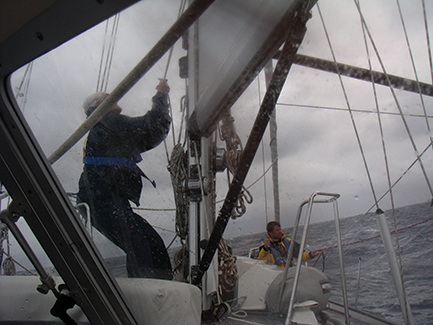
With the amount of gear and opinions available on what you should or should not have, fitting out a sailboat for blue water has never been more daunting. Couple that with the highly personal nature of the seamanship and safety decisions that need to be made, and getting a boat ready for offshore work can seem like a major obstacle to attaining the cruising dream. But it doesn’t have to be.
When cruising sailors talk about fitting out their boats for adventures on the high seas, the focus usually seems to be on big ticket items or creature comforts: a new dinghy and outboard, rigging, refrigeration, self-steering, wind and solar, etc. But there are a handful of safety considerations to take into account when preparing your boat and crew for the rigors of ocean sailing.
The International Sailing Federation (ISAF) and U.S. Sailing have been leaders in the safety at sea movement for many years, and as such, have developed a set of safety recommendations for what offshore quality yachts and their crews should have aboard when heading out over the horizon. Many of their recommendations are required for entry in offshore racing events, but cruising sailors can easily look at them as a helpful set of parameters to follow when outfitting for their own coastal or offshore passages. In the end, how you choose to outfit your yacht is entirely up to you. The following is meant as a helpful starting point when turning a weather eye towards fitting out for safety.
WHO’S IN CHARGE? ISAF begins their Offshore Special Regulations with a call to action for the person in charge of the vessel: “The safety of a yacht and her crew is the sole and inescapable responsibility of the person in charge who must do his best to ensure that the yacht is fully found, thoroughly seaworthy and manned by an experienced crew who have undergone appropriate training and are physically fit to face bad weather. He must be satisfied as to the soundness of hull, spars, rigging, sails and all gear. He must ensure that all safety equipment is properly maintained and stowed and that the crew knows where it is kept and how it is to be used. He shall also nominate a person to take over the responsibilities of the Person in Charge in the event of his incapacitation.”
This statement speaks volumes about how a sailboat and crew should be prepared before heading offshore, and based on the amount of people, including couples, who are taking sailing and safety courses and seminars these days, they are on to something.
GEAR FOR THE BOAT Choosing an offshore quality boat is the start of safely crossing large bodies of water and there are plenty of resources and opinions floating around to help with that decision. Deciding on a boat is highly personal, though, so we’ll assume you’ve done the best in choosing the boat that is right for your cruising plans.
Moving to dedicated safety equipment, having a quality life raft that is up to date on certification and designated for the amount of crew you have aboard is critical. With that, you should also have a properly supplied grab bag (see sidebar) to take with you into the life raft.
For crew safety while sailing offshore it is imperative that you have properly installed and rigged padeyes and jackstays/jacklines. The purpose of clipping points other than the jacklines is to allow for most, or all, crewmembers to be clipped in at the same time. The recommendation has also been made for crewmembers to be able to clip in before they come on deck and unclip when they get down below. Also, Dyneema or Spectra type line has been approved for use as jacklines and lifelines if they are spliced using the manufacturers recommended procedures.
In the event of a crew overboard situation, it is recommended that your boat be equipped with a throwable lifebuoy that has a 50 to 75 foot line attached to it and the boat. It is also recommended to have a GPS at the helm station with a man overboard button that will plot their position when pushed, and a waterproof high-powered searchlight to look for the person at night.
Other recommended safety items include; a storm jib with high visibility cloth or tape, a radar reflector, foghorn, first aid kit and manual, fire extinguishers, fire blanket near the stove, soft wood plugs, emergency water supply, flares, drogue or sea anchor, waterproof flashlights, and a full compliment of tools and spare parts.
That amounts to a lot of gear and a lot of dollars from the bank account, but there are plenty of stories to suggest that all these things could save your life.
In addition to a PFD, harness and tether, it is recommended that each crewmember have a knife, waterproof flashlight, and appropriate foul weather gear with marine-grade reflective material on it.
NOT JUST BUYING GEAR Responsibility and safety aren’t all about buying gear. Knowledge and experience play a major role in safety at sea and there are numerous safety at sea seminars and classes available. U.S Sailing’s Safety at Sea Seminar offers a mix of lecture and hands on learning that are helpful for anyone who is planning to go offshore. Lecture topics include emergency communications, personal safety gear, man overboard, search and rescue procedures, large vessel traffic, heavy weather, breaking seas and more.
Aside from U.S. Sailing’s Safety at Sea seminars, many sailing schools, offshore rallies and races have safety classes, symposiums and seminars designed to help those who want to sail offshore gain a strong foundation of practical safety knowledge before shoving off.
It has been said many times over that safety at sea is no accident. The truth in that speaks to absolute preparedness and the need for essential safety equipment when fitting out your boat and crew before heading offshore. Having a vessel and crew that are well founded, equipped and ready to take on the rigors of ocean sailing will not only give you peace of mind before cutting the dock lines, but could save lives if the unexpected happens.
Resources: US Sailing’s : offshore http://www.ussailing.org/education/safety-at-sea/ ISAF: www.sailing.org Marine Trades Association of Maryland: mtam.org/safety-at-sea.html Marion to Bermuda Cruising Yacht Race: www.marionbermuda.com/sas/sasreg.php
RECOMMENDED GEAR FOR YOUR GRAB BAG
Spare sea anchor (larger than the one packed in the raft) Second sea anchor for the life raft (if not already packed in life raft) Waterproof handheld VHF Radio with spare batteries A signaling whistle Fishing tackle Extra sponges Plastic bags Repair kits capable of working when the raft is wet Two red parachute and Two red hand flares (SOLAS compliant) and cyalume-type chemical sticks Handheld GPS Search and Rescue Transponder (SART) Water in re-sealable containers or a hand-operated desalinator plus containers for water A watertight flashlight with spare batteries and bulb Dry suits, thermal protective aids, or survival bags Two safety tin openers First-aid kit including at least 2 tubes of sunscreen. All dressing should be capable of being effectively used in wet conditions. The kit should be clearly marked and re-sealable. High energy food Nylon string EPIRB/PLB Knife Seasickness tablets (min 6 pp recommended)

Administrator
You might also like.
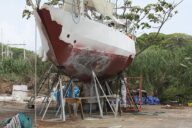
Problems with Paint Application Q & A

Dinghy Security

Winterizing Your Engine

Read the Summer-Fall Edition of Blue Water Sailing
Read the fall 2023 edition of blue water sailing, recent posts.

- The Outremer 52 Combines the Best of Two Great Predecessors, the 51 and 55

- New Solaris 55 to Mark Builder’s 50th Anniversary

- A Sailing Watch is a Useful Tool
Please Visit Our Sponsor’s Webpages
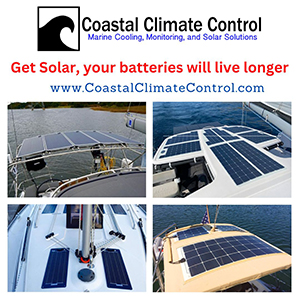
- Media Advertising & Rates
Published by Blue Water Sailing Media, a division of Day Communications, Inc., Middletown, RI
Publisher & Editor: George Day
Blue Water Sailing Media publishes Blue Water Sailing magazine, Multihulls Today and other titles.
Cruising Compass Advertising Sales:
George Day, Newport, RI [email protected] 401-847-7612
- Starlink Increases Subscription Rates for Some Users
- A Quick Guide to Cruising to Foreign Lands
- Survey of the Week
© 2014 Blue Water Media. All rights reserved. | Admin

Please verify you are a human
Access to this page has been denied because we believe you are using automation tools to browse the website.
This may happen as a result of the following:
- Javascript is disabled or blocked by an extension (ad blockers for example)
- Your browser does not support cookies
Please make sure that Javascript and cookies are enabled on your browser and that you are not blocking them from loading.
Reference ID: f8d0db2c-1b17-11ef-8b0c-09a75b7fcd96
Powered by PerimeterX , Inc.
41 Sailboat Cruising Essentials for Long Trips
In this post I list the items you are unlikely to have if you have never done bluewater or long-term cruising before. There are some essential safety product and also a couple of cool upgrades which will help you be comfortable.
What do you need for extended sailing trips? When going on an extended sailing trip, you need additional navigation and safety equipment, like a life raft, AIS transponder and satellite phone. There are some upgrades you might consider, like self-winding winches and autopilot. For ocean passages, you might need a watermaker and generator.
There's an endless list with upgrades you could do. But if we look at the bigger picture, it's actually just some fundamental changes. If you get these, outfitting your boat for long cruises is easy.
Download the printable checklist here - 100% free
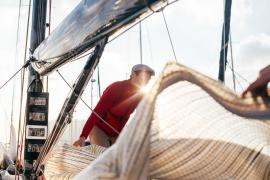
Interactive List of Cruising Gear Essentials
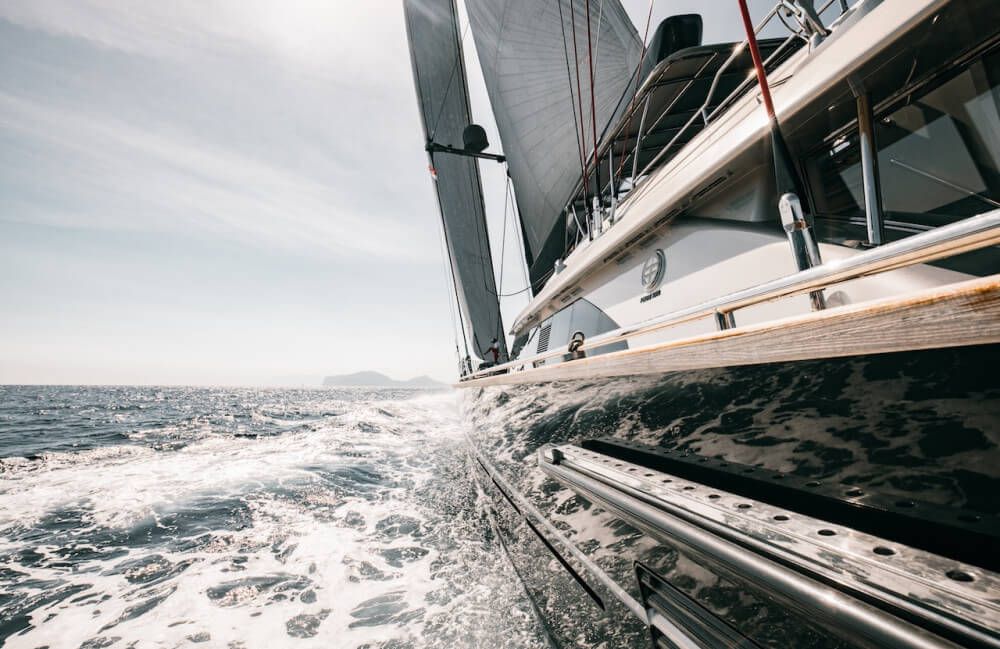
On this page:
The biggest changes to your boat, sailboat essentials to travel and live comfortably, essentials for maintenance, additional safety equipment, things to consider before leaving, related questions.
If you're used to short sailing trips, a couple of things change when going on longer trips. The role your boat plays changes.
First off, it really depends whether you're planning an ocean passage or just a long trip on lakes. If you stay inland, you need less equipment.
For bluewater cruising, the change is the biggest. All of a sudden your boat is a liveaboard boat. On long cruising trips, you need to be self-reliant. You need a source of electricity, more safety gear, and a water maker.
Now that you'll be onboard for longer, these are the things that become more important:
- traveling comfortably - because you travel for longer distances, you might want to upgrade some sailing gear and sailboat parts to improve the sailing experience.
- living well and comfortably - you live on it, so you need to be able to be comfortable and take care of yourself.
- maintenance - you travel in it, so you need to be able to keep on traveling.
- traveling safely - with bluewater cruising, you need some additional safety gear.
So let's dive in. Here's my list with cruising essentials:
1. Watermaker
If you're about to set off on an ocean voyage, you need a watermaker. Watermakers are used to desalinate seawater. They only effectively desalinate about 10% of the water, and they require a lot of pressure (about 800 psi). Watermakers are quite large so you need to build it into one of your cabinets. They're also expensive.
So these are a couple of reasons why getting the right one can make a lot of difference.
You use on average 4-6 gallons of water each day per person. Desalinators filter anywhere from 1-8 gallons of water per hour.
So I'd say the biggest advantage of a watermaker is weight: water weighs a lot and having the option to just suck it out of the ocean instead of carrying around a 750-gallon water tank helps a lot to reduce weight, improving your overall sailing performance and speed.
2. Some Sort of Generator
With long trips, you need to be self-reliant and provide your own electrical power. Most long-term cruisers use some sort of generator to do this. You basically have four options:
- traditional generator
- solar panels
- wind generators
- hydro generators

The traditional generator is still the most commonly used option. But solar is on the rise, and I've seen an increasing amount of wind generators on sailboats. I don't know a lot about them, but I do use solar myself.
A generator is expensive and picking the right one is important - not just for the initial price, but also for the cost of usage. Traditional generators are a bit cheaper initially, and a bit more expensive to use in the long run. Although solar isn't free.
3. Self-Winding Winches
Self-winding winches are winches that hold the line for you while turning the winch. They make life onboard so much easier. They're especially great if you're sailing solo. Some people think they're not worth the investment, and I agree. Replacing the winches is way to expensive for just the extra comfort. But what if I told you, you can upgrade your existing winches at a fraction of the cost ?

I've written an article about how to upgrade your winches to self-winding yourself - read it here (new tab).
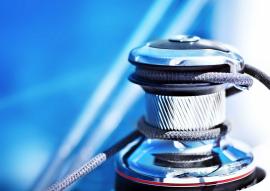
3 Ways to Convert Your Winches to Self-Tailing
4. roller furling sails.
Another major investment that will make cruising life so much more pleasant. Roller furling sails allow you to quickly reef down your sails without much hassle. It does it for you. Great if the weather turns on you.
Agreed, you don't need them. But these might very well be worth the investment. Especially a roller furling jib is worth it. Be aware though that a roller furling mainsail is very expensive - you probably need to replace the mast.
5. Refrigerator
Long trips mean long days, and that means you deserve a cold beer at the end of it. This is one of these household items you simply need for taking care of yourself. You need to keep your food fresh. Especially important with ocean passages, where you could be self-reliant for up to three weeks.

6. Some Sort of Cockpit Canvas
There are multiple options for keeping your head out of the sun - and if you're constantly in the beating sun, you want some cover. You could also get hardtops, but I personally like canvas a lot more. You can change it around that way. Definitely worth the investment.

The Mobmat hangs on the side of the boat. It's a great tool for getting someone out of the water in case of a man overboard. This handy little chair reduces stress in worst case scenarios. And it's also a great hammock for relaxing in the sun.
You can check it out here: Mobmat at ADEC Marine .
8. Autopilot
Autopilot is one of those electronic upgrades you can't really do without if you sail for days on end for longer than 5 hours a day. Especially if you have to cover ground, this is the best way to get by - it allows you to sail at night, while just having someone on watch. But it also helps to reduce the stress of the day a lot - not having to man the helm continuously.

9. Handheld Vacuum
This is one of those items that you only come up with after having lived on your sailboat for some time. It's one of my favorite items on this list (apart from #29 - spoiler, it's a foldable bike) because it makes so much sense. A sailboat can be a pain to clean, but it isn't with a small 12V handheld vacuum cleaner.
I really like this one (click to check current price on Amazon ).

It's a fair price for a powerful vacuum. The best part is that it's able to clean liquids, which is advantageous on a boat. It has served me well. It really increases the quality of my life. I'm not kidding.
10. Outdoor Shower Head
If you like to be clean, this is the best investment you could do for longer trips. Even if you plan on staying in marinas most of the time, this saves you a trip to the showers. You can attach the shower heads to the stern and use them to quickly wash after a salty swim.
11. Water Cans
This one's obvious but it's a shame if you forget to bring them. A couple of 1-gallon water cans will provide you with plenty of freshwater for the day.
12. Headlamp or Flashlight
Having a portable light source is absolutely necessary when you're on your own. I found this out the hard way. One day we found ourselves at the center of a thunderstorm. We were at anchor in the middle of a lake. We felt an urge to move the boat in the dark. Navigating without a light is a pain.
I use this Zebralight Headlamp (click to check current price on Amazon ).
It's way more powerful than any other flashlight I have. It's also practically unbreakable and has rechargeable batteries. I've been a great fan of this head torch for a long time now.
13. Anchors (3)
For open water sailing, you need additional anchors. Ideally, you have your regular anchor and two storm anchors. This is maybe also a good time to invest in an anchor system and roller.
14. Satellite Phone
A boring piece of equipment, but absolutely essential if you are getting off the grid, so to speak. When getting out of range, you want to have a reliable means of communication. The satellite phone never fails and gives you the means to communicate in times of need.
15. Your Car: Picking a Tender
The most popular tenders are rigid bottom inflatables or RIBs.
Having a tender allows you to do two things:
- you can get on shore at beaches while leaving your boat at sea
- you can use anchorages and motor to shore
The first one just looks ridiculously cool. The second is impressively cheap compared to marinas. It's about 5x cheaper to use an anchorage than a marina. Also: there are probably way fewer people there.
So while a RIB can be expensive at first, it can pay for itself. For my trip to the Meds, I'd probably earn back the RIB within a year.
This is currently the most sold dinghy on Amazon . It looks great to me, and it's fairly priced.
16. Picking an Outboard for your Tender
Consider getting an electric outboard, which is way more powerful and durable. It also means you don't have to carry gas. Although the RIB will be heavier because of the batteries.
If you want to get an electric outboard, I'd recommend getting this one from Goplus (link to check current price on Amazon ), which gets you the best bang for your buck.
Also, make sure you have the means to recharge the tender.
17. Radar enhancer
Radar enhancers are super useful. They warn you if the radar of another vessel picks you up. So it's kind of like a passive radar. This means you don't need a radar yourself (which means less energy consumption), but you will know ahead of time that someone is closing in on you.
18. AIS Transponder
More boring electronics. No, actually I love technology.
AIS stands for Automatic Identification System. The transponder goes in your mast head and transmits a signal to other boats. It helps you to avoid collisions. If you think an AIS is overkill, together with the radar enhancer, I'd choose the AIS over the enhancer.
19. Antennas and Range Extenders
These help to extend the range of your navigation and communications equipment, like your chartplotter. They are a must if you plan to do ocean passages, where you'll probably get out of range for most electronics.
20. Handheld GPS
For extended voyages, you need a reliable navigation backup. Most people prefer a handheld GPS. I personally love a reliable compass with some charts. Both have their pros and cons. If you want to be completely safe, carry both, or carry a sextant instead.

I like to bring three navigation tools with me that all three rely on a different input.
I have made a recommendation for a reliable and accurate handheld GPS in my article on chartplotters. Click here to learn which one to get .
If you want to know more about the different marine navigation types , I highly recommend to read my article about it here .
21. For Cold Weather: Hurricane Lamp
It can get quite cold on the water, especially at night. I like to bring a hurricane lamp to warm the cabin a bit. I don't like heaters: I don't need them, don't want to install them, and don't want to fuel them. But a simple hurricane lamp works great for that real cold night.
22. Or Hot Water Bottles
Another great tool - my girlfriend uses these at home as well. And who can blame her, they're so comfortable ... (I don't like to admit that I use them too in secret). Hot water bottles are just simple rubber bottles. You fill them up with hot water and they stay warm for an hour or so. A great and easy way to stay warm.
23. Fishing Tackle
A fishing rod and some tackle don't take a whole lot of space. And it sure is a handy way to get yourself some food when you're in need of it. For me, the math is simple:
- If you don't bring your fishing rod and are in need of food, you are in trouble
- If you do bring your fishing rod, you're floating on top of the largest drive-through on the planet
It's just a great reliable backup to have. And if you're not in crisis, it's still a great way to relax.
No better way to prepare the catch than on a propane BBQ. I like to bring a small and sturdy one. Doesn't use a lot of gas, inexpensive, and doesn't fall over when the boat rocks.
25. Portable Marine Stereo
I have to admit, we are done with the essentials and have arrived at the nice-to-have section. But sailing long distances can be boring for some people, although I love the quiet and piece.
If you do want to break the peace, I recommend you do so using a portable marine stereo, which doesn't merely look good, but also provides killer audio quality for its price.
I have this portable JBL Charge 4 (click to check current price on Amazon ). It's waterproof. The sound quality is plenty good for the price. I was really surprised by the volume and the amount of bass in this speaker. I even find the bass a bit off-balance (too loud) - but that's me.
They also have more high-end models, like the JBL Boombox, which is also waterproof and replaces your high-fi stereo system. It's a bit more expensive but I think JBL delivers on their promise.
26. Outdoor Lighting
Sitting on the deck at night, beneath the stars, is just great. But if you're trying to relax and have a conversation, it's nice to have some ambient light. Luci Lights are perfect for marine purposes. Waterproof, solar powered, and very attractive.
You can check out Luci Lights on Amazon here .
27. Change Lighting to LEDs
A great way to reduce your energy consumption is switching out your cabin lights with LEDs. Your energy needs will halve by a simple switch. LEDs aren't expensive nowadays, and batteries are, so I think this one is definitely worth the (time) investment.
28. Stove Top Coffee Maker
A stove top coffee maker. The Italians call it a 'Moka'. Some use it as a compromise - saying it gets you the best coffee in those circumstances. I disagree. I use my Moka every day. I don't have a coffee machine (and I drink a lot of coffee). I find that a stove top coffee maker gives better coffee than most machines, more consistently, and it's way easier to use and clean.
I just love simple stuff that works great.
29. Foldable Bike
My favorite. Maybe apart from the tender. Earlier I said the tender is sort of your car. But actually, this is. Most sailors operate in a small range within the marina - which makes sense. You travel on water, and then you want to rest a bit.
But I love to ride my bike, and this allows me to get my groceries in town instead of in the marina. It allows us to get to a good restaurant without renting a car (so we can drink a couple of wines as well).
The best part is: you get to the toilet way quicker on this thing.
30. Foul Weather Gear
There's nothing sadder than manning the helm in the pouring rain. Wait, there is: manning the helm in the pouring rain in your kakis. Especially if you will be sailing open seas, foul weather gear is essential.
31. Any Extra Sails You Might Need
If you don't have them already, make sure you carry all the sails you'll need. Re-evaluate your sail plan. I might want a storm jib for ocean use, and a spinnaker for light airs, for example.
To get a complete overview of the different sail types and uses, I highly recommend reading my guide on sail types . In this article, I'll walk you through all the basic sails.
Some essential tools I like to carry to do on-the-fly maintenance.
32. Oil Drainer
Bringing an oil drainer only makes sense for long sailing trips. But it's such a clean and hassle-free way to do an oil change.
For most marine motors, you need to change the oil every 100 hours. However, changing the oil more often is better for the engine. 100 hours may seem like a lot, but it's actually not. If you plan on sailing for more than two weeks, and you find yourself without wind most of the time, there's a good chance you'll use the engine for 100 hours or more.
Oil drainers are inexpensive, and they make an oil change so much quicker and especially less dirty. I always have one onboard.
33. Toolkit for Minor Maintenance
If you need to be self-reliant, you need to be able to do minor repairs on the rigging, sails, and engine.
I like to be self-reliant, regardless of whether I'm doing a small trip or long - this also goes for my car as well.
That's why I always carry a basic toolkit that contains at least:
- 12V cordless drill
- basic hand tools
34. Fuel Cans
Carrying spare fuel is always a great idea for longer trips - even for short ones (I found out with a couple of friends).
How much fuel should you actually carry? It's easy to calculate. Find out how in my article on fuel usage here (opens in new tab).
35. First Aid Kit
I always carry a basic first aid kit. It contains:
- pain killers like aspirin, or something heavier
- large bandage
This helps me to stop bleeding, treat minor injuries, and cuts. For extended voyages, the first aid kit is supplemented with antibiotics and disinfectants.
A quick summary of some additional safety equipment that's required or you might want to consider.
- Fire extinguishers
- Crash Blanket
- Nautical Flags
- Lifesling hoisting tackle - not required but nice to have in heavy weather ocean sailing
If you want to know what safety equipment you need exactly, I've previously written an article about it. Read the article on USCG safety requirements here .
Checks and maintenance
You might want to check the following before leaving
- the ground tackle
- the rigging
- electronic systems
- propellor and engine
You might want to do some maintenance on:
- the hull (anti-foul painting, for example)
- clean the exhaust manifolds
- converting the boat for saltwater use (if necessary)
If you want to know more about how to convert your freshwater boat for saltwater use, you can read my article here .
If you don't already know how to, you might want to consider learning how to maintain the engine and do minor repairs around the boat. I like to know how to:
- change the oil
- flush the engine after saltwater use
- monitor the engine's health (correct RPM)
- repair minor sail damage
- repair the water maker
- check the electricity system for problems
- rewire the electronics
When should boat oil be changed? It's recommended to change the oil of your boat engine at least once a year or after 100 hours of running time. This is the recommendation of manufacturers. Increasing oil changes will extend engine life. Postponing an oil change may cause damage to the engine.
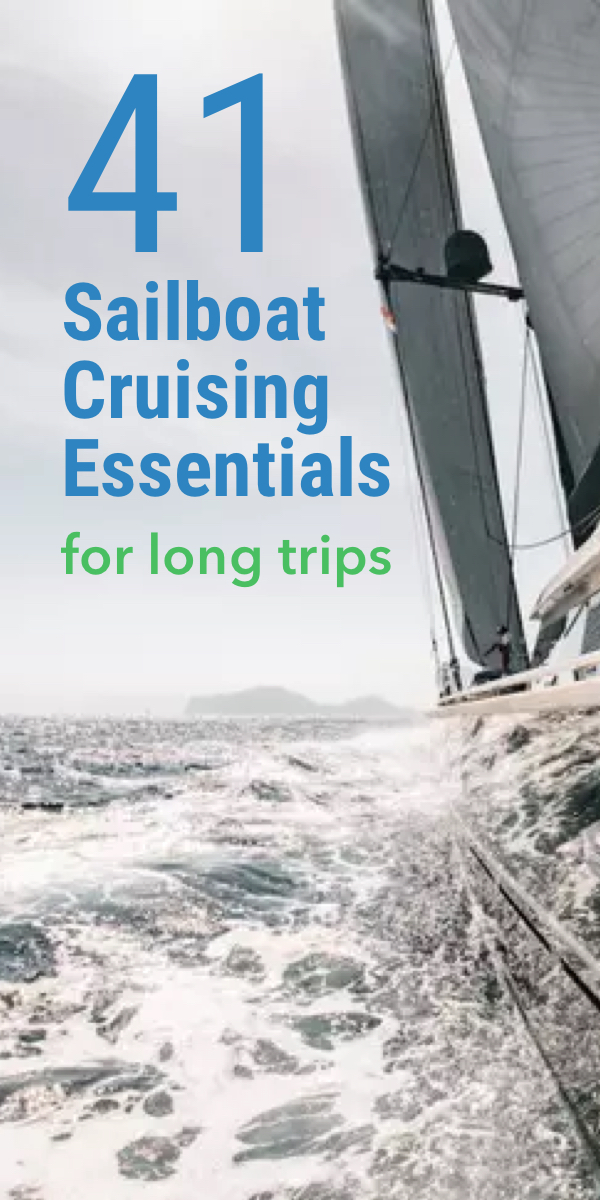
HERSCHEL WEEKS
Terrifically written and very sound advice. I am getting ready for a trip .. I will take a second look at some of my systems. Thanks, Herschel
Filip Larsen
Great artickle (articles). Very usefull.
Daniel Egeland
Very good info. I’m in the planning phase for some long haul sailing that will start in about 3 years. Good list to start off with! Dan
Leave a comment
You may also like, how to convert your freshwater boat for saltwater use.
Some people say that freshwater boats will die in saltwater: a boat that 'has seen salt' won't sell as quickly - myths if you ask me. If you're planning to move …
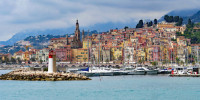
9 Practical Tips & Locations for Sailing the Mediterranean

How Long Does it Take to Sail Across the Atlantic? (With Maps)
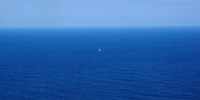
What Is Bluewater Sailing?

How Far Can You Sail In One Day?
Own your first boat within a year on any budget.
A sailboat doesn't have to be expensive if you know what you're doing. If you want to learn how to make your sailing dream reality within a year, leave your email and I'll send you free updates . I don't like spam - I will only send helpful content.
Ready to Own Your First Boat?
Just tell us the best email address to send your tips to:
Outfitting a sailboat for long-term cruising can seem like an overwhelming task. With so many things to consider, it can be difficult to know where to start. If you’re serious about cruising and want peace of mind in knowing you have all the most important things onboard. Here are 10 essential items for outfitting your sailboat for long-term cruising that no sailor should be without.
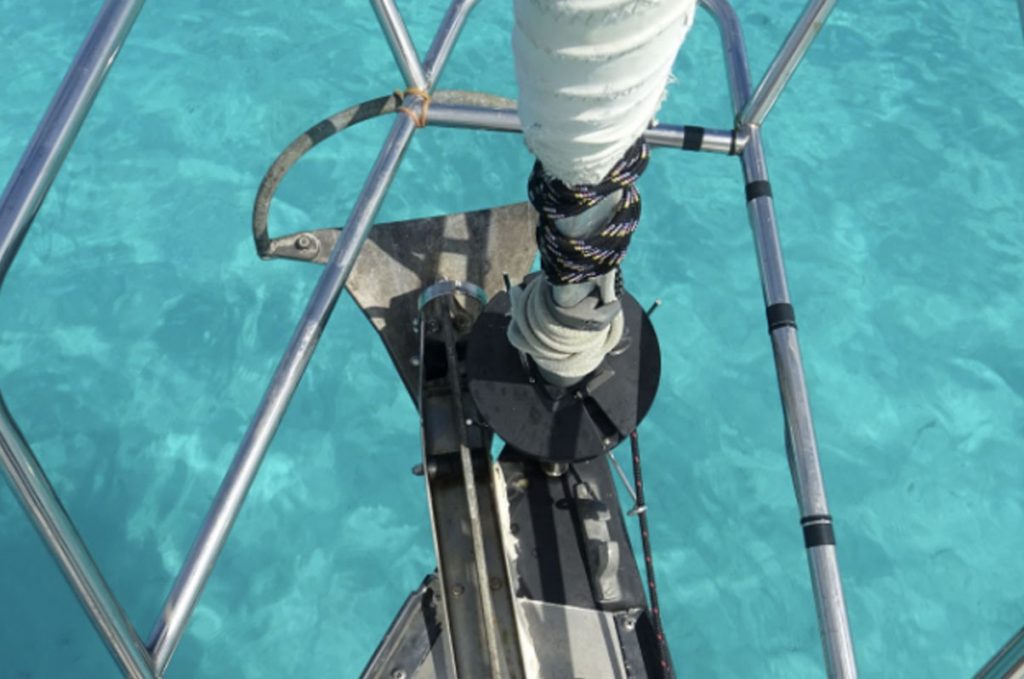
1. Anchor
The first and most important item on the list is a quality anchor and chain. A good anchor is essential for sleeping well at anchor, and it’s important that it is strong enough to hold in a variety of conditions. I recommend going with an anchor that resets itself easily with a wind shift like a Mantus or Rocna. A quality chain with the right amount of scope will also help to ensure that your anchor stays firmly in place. When possible, it’s best to use a ratio of 7:1 scope, which means for every foot of water depth, you should have 7 feet of chain out. This will help to ensure that your anchor sets properly and won’t drag in changing conditions.
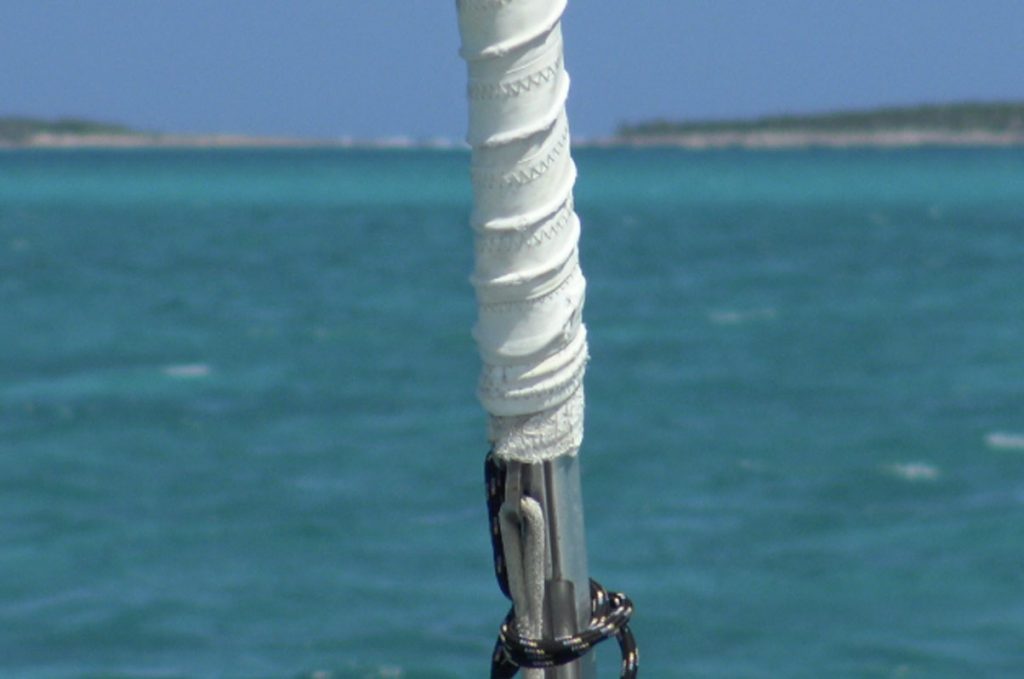
2. Furling Headsail
Next, a furling headsail is a must for many when cruising long term. This versatile sail that can be unfurled and furled from within the cockpit, making it easier to adjust sail trim in changing wind conditions. This is especially useful when sailing short-handed in more challenging conditions.

3. Watermaker
A watermaker is also an important item for comfortable long-term cruising. A watermaker will enable you to turn salt water into fresh water, which can be used for bathing, washing dishes, and drinking. This can also be a lifesaver during long passages when you’re running low on fresh water. It’s a great alternative to lugging your water by dingy but for longer times away from civilization the watermaker is absolutely needed. We do not have one on board currently but it is high on our list of upgrades to get.

4. Dinghy
Having a quality dinghy and reliable outboard motor is just as important as outfitting your sailboat. A dinghy and outboard are useful for getting to and from shore, as well as for exploring shallow waters that your boat may not be able to access. It replaces your car at home and we all know just how important a vehicle can be with no access to public transit. Groceries, water (without a watermaker), fuel, adventure, are just a few examples of things we use a dinghy on a daily basis. It can even be used to propel your vessel during an engine failure, surprisingly well i might add.
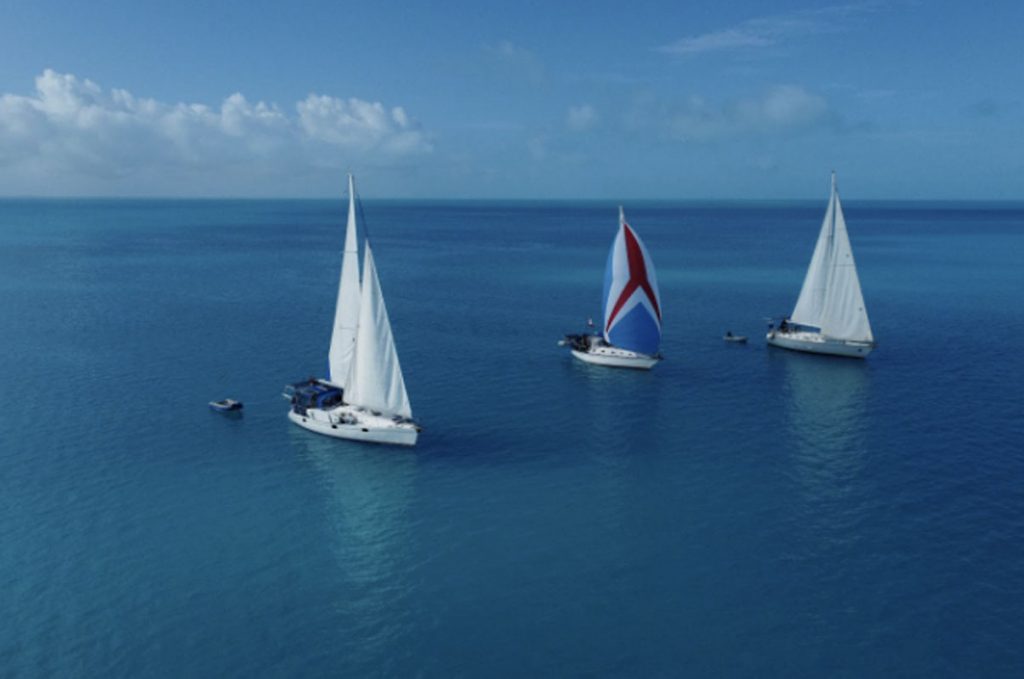
5. Sails
Sails and a sail repair kit are also essential for outfitting your sailboat for long-term cruising. Sails are needed for powering your boat in different conditions, and a sail repair kit is useful for making quick repairs at sea. It’s important to have a variety of sails onboard, from storm sails to light air sails, and a selection of sail repair materials such as sail tape, webbing, and thread. Additionally, it’s important to understand the basics of sail repair and maintenance so that you can make the necessary repairs when needed. Having the right sails and a sail repair kit onboard will help you make the most of your time out on the water.
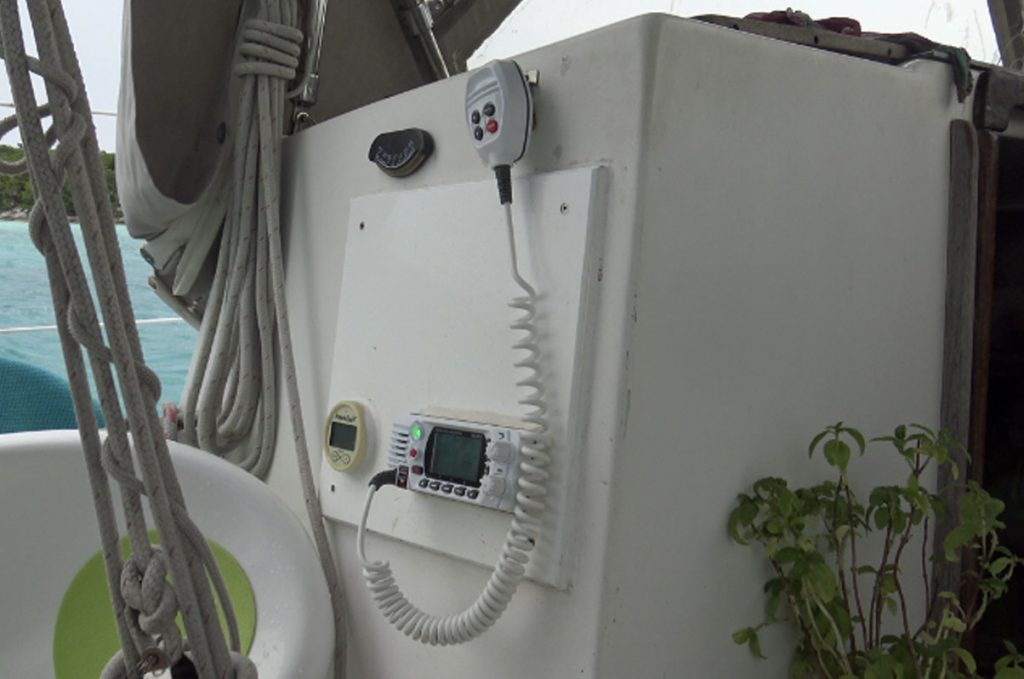
6. Navigation Equipment
Navigation and communication equipment are also essential for outfitting your sailboat for long-term cruising. Navigation equipment is for planning and executing passages, while communication equipment is needed for staying in contact with other vessels, marinas, and land-based services. A tablet with your favourite charting app paired with a VHF radio is how we accomplish this.
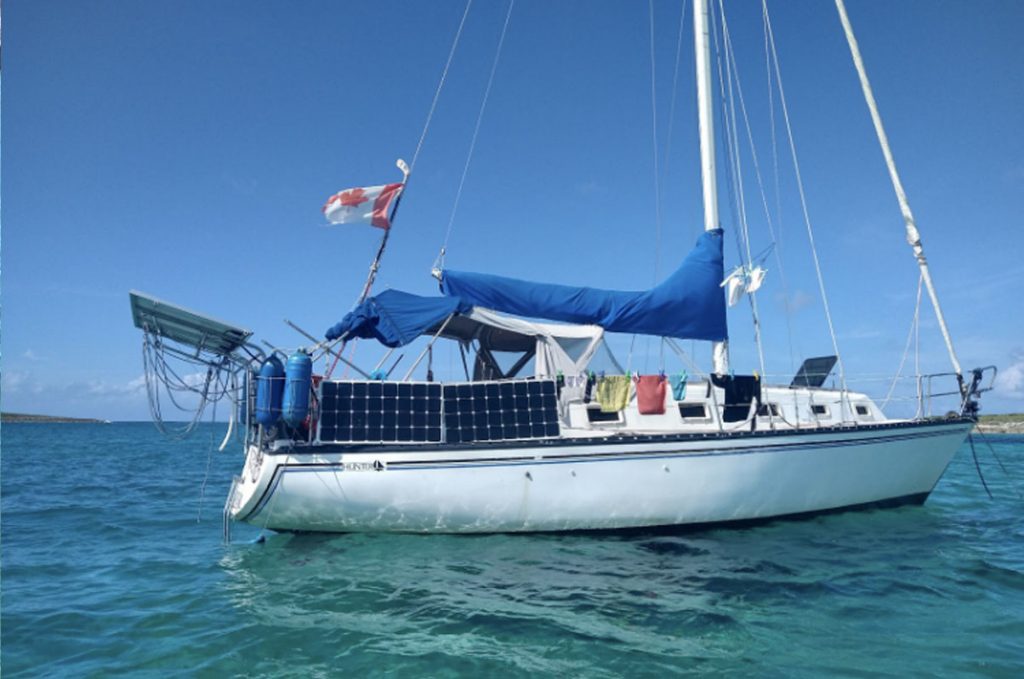
7. Solar Panels / Wind Generator
Solar panels and/or a wind generator are also essential for outfitting your sailboat for long-term cruising. These can be used to generate power for running electrical equipment and charging batteries, removing the need to go to an expensive dock to plug into shore power. Additionally, solar panels and wind generators can be useful for generating enough power to run a fridge and other appliances, allowing you to be more self-sufficient and reduce your reliance on external sources of power. When choosing solar panels and/or a wind generator, it’s important to consider the type and amount of power that you need, as well as the size of the panels or generator that will fit on board your boat.

8. Spare Parts
Spare parts and tools for maintenance are essential for keeping your sailboat going during a long term cruise . Having spare parts and tools onboard can be a lifesaver if you find yourself in need of a repair while at sea. It’s important to have a variety of spare parts and maintenance tools, from basic hand tools to specialised equipment for more complex repairs. Additionally, it’s important to understand the basics of sailboat maintenance such as inspecting the rigging, servicing the engine, or just putting down a fresh coat of paint. Having a good understanding of how to maintain your vessel can help you make the most of your time at sea.
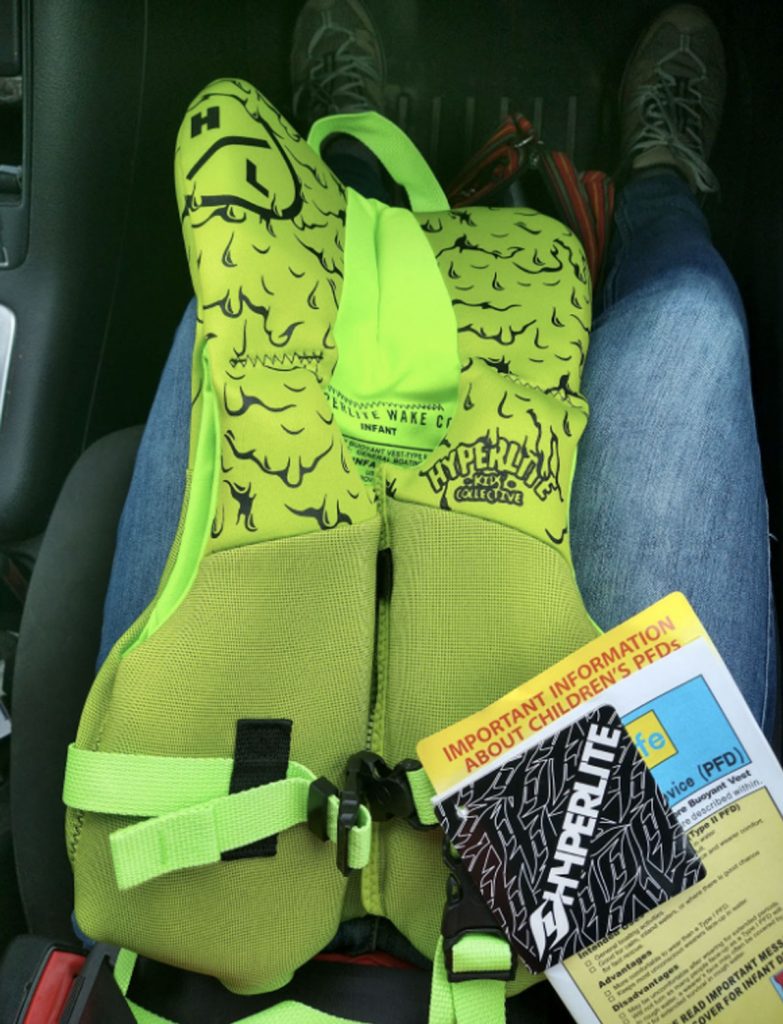
9. Emergency Supplies
Additionally, emergency supplies such as life jackets, flares, a first aid kit, and a fire extinguisher are essential for ensuring your safety and security while underway. Depending on the size of your vessel and home port, you will require different amounts of supplies. A well-stocked first aid kit is especially important for providing basic medical care when needed, these supplies may just save your life in an emergency.

10. Mask and Snorkel
Finally, a mask and snorkel can be invaluable for a sailor outfitting their sailboat for long-term cruising. This one almost didn’t make it on the list but considering how useful it is I would never be without one. A mask and snorkel can be used to un-foul an anchor or chain, clear a jammed thru-hull, clean the hull of your boat, clear a tangled prop, or even catch yourself some dinner! A mask and snorkel can also be used for recreational activities such as exploring shallow waters, snorkelling, and experiencing the beautiful world below the surface. Additionally, a mask and snorkel can be a great way to cool off and relax while at anchor.
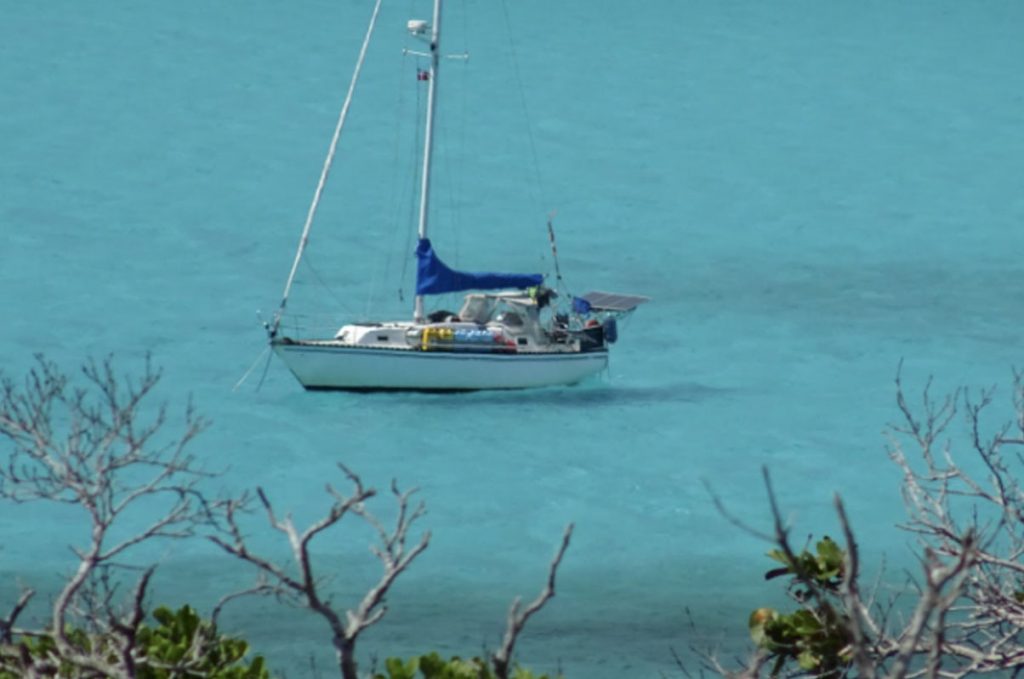
Outfitting your sailboat for long-term cruising can be a daunting task, but having the right items onboard can make a huge difference in your comfort and safety at sea. Quality anchor and chain, furling headsail, watermaker, dinghy and outboard motor, sails and sail repair kit, navigation and communication equipment, solar panels and/or wind generator, spare parts and tools for maintenance, and a first aid kit are all essential items for outfitting your sailboat for long-term cruising. By having these items onboard and understanding the basics of sailboat maintenance, you can ensure that your vessel is well-prepared for any situation that may arise and make the most of your time out on the water.
Cory Bertrand
Cory and Alex share their adventure with weekly videos on their YouTube channel “ Wildly Intrepid Sailing ” and share stories on their website www.wildlyintrepid.com . Their dream is to travel the world and to live without any regrets.
Sign up for our Newsletter
Enter your details and receive exclusive news, deals and more!
Boat Gear & Outfitting
Outfitting a boat to cruise – or circumnavigate – is really hard work. We finished our circumnavigation in 2020, and have learned what works on a cruising boat – and what doesn’t.
The number of items you can order for your boat off Amazon is amazing. Many of the best items on our boat are ordered from Amazon.
Boat Gear: Fun & Active Stuff
- Snorkeling Off Your Cruising Boat
- Exercising While Cruising
- iPaddleboards v iKayaks
- Fishing Gear for Cruisers
- Set Up and Review of Sea Eagle Inflatable Kayak
- Video Gear & Cameras for Sailing Videos
- A Year with our Drift Paddleboards
Boat Gear: Galley Equipment
- Magma Pots & Pans
- Reducing Disposable Plastics in the Galley
- What’s In My Galley
Boat Gear: Miscellaneous
- Flex-o-fold Folding Propellers
- Using the Marie Kondo Method to Tidy Our Boat
- Cruise RO Watermaker Review
- Tools for Cruising Boats
- Communications While Cruising
- Marriage Saver Headsets
- Five of our Favorite Things
- Offshore Medical Kit Contents
- Books for Cruisers
- Foul Weather Gear
- Our Mantus Anchor Unboxing
- Man Overboard
- Book Review: Care & Feeding of Sailing Crew
- Our First Christmas Gifts as Cruisers
Boat Outfitting
Our boat outfitting was a 3-step process. We started in La Rochelle, where we picked up our new Fountaine Pajot Helia 44. We did the barebones work needed to make us comfortable bringing her across the Atlantic double-handed, working with Uchimata. When we arrived in Miami, our broker completed the commissioning and we did some projects there. Then, we sailed around to Palmetto, Florida, where we spent three months getting the final big projects done.
- Selecting Factory Options
- Electrical Systems for Cruising Boats
- Outfitting a Cruising Catamaran
- Palmetto Projects: Enclosure and Hardtop
- Palmetto Projects: Solar
- Dropping the Temperature
- Anchor Chain Upgrade
- Custom Silverware Organizer
- Choosing our Trampoline
- Hydrogenerators
- November 2015: BVIs – at Nanny Cay
- February 2016: Grenada Marine
- December 2016: Whangarei, New Zealand at Norsand Marine
- June 2017: Vava’u, Tonga
- January – March 2017: The Boat Works, Australia
- January 2019: PSS, Thailand
- February 2019: G&T Boat Yard
Boat Projects
- Running Lines Through the Mast
- Swapping and Cleaning a Transducer
- Converting Heads to Freshwater
- Swapping a Windlass Gypsy
- Re-bedding Deck Hatches
- Resizing Battens
- A Perfectly Executed Boat Project
- DIY Bottom Job
- Repairing our Quick Chain Counter Sensor
- DIY Dyneema Lifelines
- Replacing our AGM Batteries with Lithium-Ion
- Three-Year Maintenance
Offshore Medical Care
- Medical Books to Keep On Board
- Offshore Emergency Medicine Course
- Vaccines for Cruisers
Latest Posts
- Best Modern Sailing & Cruising Memoirs
- Our Electrical Refit and New Catamaran Solar Arch
- Flexofold Folding Props Review
To go to our website and order the video click here.

Home » Blog » Travel » Small sailboat, small budget, BIG adventure
Small sailboat, small budget, BIG adventure
By Author Guest Post
Posted on Last updated: December 4, 2021

“I’m a twenty-year-old sailor, but I would identify as an old salt.” says Cooper VonAchen. Cooper is preparing to sail from California to Mexico and the South Pacific, but he’s gone about it differently: namely without a big boat, fancy electronics, complicated systems, or even a marine head! “I preach simplicity and truly voyaging under sail… not your diesel.” Today, he shares how he equipped his small sailboat with old technology so he could afford to go cruising while he’s young.
The ultimate “Go small, go simple, go now” cruising philosophy
People tell me there are all kinds of things I “must-have” in order to go cruising: an electronic chart plotter, autopilot, etc.… But when I hear people launching into this ever-growing list of items, I find myself thinking, “That would be nice, but I want to go now.”
Being only twenty years old, I haven’t had a lot of time to work and save for the ideal cruising machine, “Go small!” people told me. However, I quickly discovered that “small” doesn’t always mean affordable. For example, a Dana 24 is an amazing small cruising sailboat, but you would be hard pressed to find one for under 30K. A 28 ft. Bristol Channel cutter can easily cost upwards of 100K dollars! How about one of the handful of small bluewater boats that fall into the category of “Go small, go simple, go now,” but cost an outstanding amount of money? How does someone young and broke afford one of these “small” sailboats? You can’t.
My solution was to go small in size and price. That may sound like complete idiocy; everyone would love to find a sweet little boat and pay next to nothing for it. I bought my Canadian Sailcraft 27, a rugged, wide-beamed, seaworthy design (and the cutest boat you’ll ever see in an anchorage or marina) for 8,000 dollars. I would say that is next to nothing for a small cruising sailboat. All of her standing rigging is brand new, she has a lightly used Yanmar diesel, there isn’t any delamination or water in the decks, and she came with a full set of sails, including a brand-new mainsail. You can’t ask for much more than that for $8,000. But this took constant searching and looking for a boat that was in my price range and wasn’t complete junk.
Looking for a cheap sailboat? Check-out How to find cheap boats for sale on Craigslist and the best places to look for used boats.
This wasn’t a one-off however. There are numerous small sailboats out there that aren’t considered to be bluewater cruisers that can easily get the job done. The Newport 30 MKII is a great small sailboat that has made several pacific crossings to and from California and Hawaii. If it can do that, then why not take it farther. You would be surprised what some of these “coastal cruising” boats are capable of. People have taken homemade rafts across the Pacific for crying out loud. You can take a small sailboat with stainless rigging and a fiberglass hull and do the same thing, with great comfort and safety.
Now, the second part of the famous Pardey saying is “go simple.” Simplicity is key my friends. Simple works and doesn’t break easily. Simple will allow you to get to a destination and enjoy it rather than “fixing your yacht in paradise”. Go simple on the electronics. Do you really need a wind indicator, a knot meter, and electronic chart plotter, a big screen GPS, an expensive and power-hungry autopilot? No, you don’t. You actually don’t need any of these things to enjoy cruising. What you do need is good sails, a sound hull, a handheld GPS, plenty of water and food storage, a good anchor with plenty of chain, paper charts, a reliable dinghy, and a means of self-steering. A simple list. Many go small, but few go simple.
Editor’s note: Lin and Larry Pardey have written dozens of books on cruising including this classic “Cost Conscious Cruiser” with tons of great cost-saving tips.
Think about trying to fix your marine head in an isolated island chain. How do you fix the absolutely disgusting problem of a malfunctioning head and blocked holding tank system? Believe me, I know how bad this can be… and you don’t want to know. I’m not saying rip out your head and holding tank and make a composting bucket head like I did, but just think about other examples. What if your water pump breaks in your galley and you can’t get water out of the sink without siphoning it out of the holding tank? Why not just install manual pumps in your galley and head to eliminate the issue from ever arising? I know this can be a pain, pumping away just to get water out of your faucet, but time not wasted on fixing your boat is time spent enjoying the places you worked so hard to be.
Now I don’t need to go into detail on exactly how I outfitted my small cruising sailboat, less electrical more manual systems, because you can just apply this ideology into your own outfitting process. In any place where you can eliminate complexity and cost, do so.
Self-steering is a tricky subject. It is very hard not to spend large amounts of money on self-steering gear. Whether it be an electric autopilot, or a wind vane, you are going to spend money on self-steering. Unless you are as crazy as me and just can’t wait until you have the funds to purchase such a device. I went with the sheet-to-tiller method of self-steering. Now you experienced Yachtsman are going to turn your nose up at such an outrageous choice of self-steering gear as there are only a handful of people crazy enough to use this method to steer their boat across oceans. If you do not know what sheet to tiller is, you effectively use the tension in your sails to apply negative feedback into your boat, more or less keeping it on course without anyone touching the helm. This method is wonderful for one reason alone, it cost roughly 100 dollars for a system that can keep your boat on course. Now there are many downsides to such a decision. First, this system only works with a tiller, not a wheel. Second, any time that the power or direction of the wind changes, you are adjusting the self-steering gear. So effectively you have to adjust your boat every hour or so to keep it on course. That means if you are single handed, you only really have an hour at a time to sleep at night during a crossing or an overnight sail. t forces you to sail your boat more, which if you enjoy sailing, is not such a bad thing.
Many cruisers would also like to talk about dinghy choice, hard or inflatable? Outboard or rowing? But what do you think I chose? I chose a hard dinghy that can row well. Cheap Outboard motors break down constantly and good luck finding parts in remote atolls. Oars don’t stop working. A hard dinghy can take a beating and continue to float and get you and your crew to shore. Inflatables spring leaks and need to be patched all the time. UV radiation can deteriorate the fabric of inflatables causing you to replace your tender every couple of years. That does not fit into my philosophy of simplicity.
Editor’s note: We used a rigid Costco Kayak as our tender for our entire 8 month Pacific Crossing. Inexpensive and indestructible!
I think you can extrapolate the rest my outfitting process just from my self-steering choice alone… minimal. I only chose exactly what I will need, not what I want, or what will make life as easy as possible, but what will give me the most time to enjoy cruising. Because if you are working on your boat or working to pay for it in the first place, you will never truly enjoy what the cruising life has to offer because all of your time is being eaten away by what many would consider vital necessities.
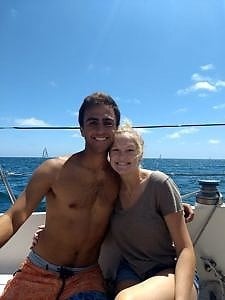
Follow Cooper’s story on his blog https:// theadventuresofcaptaincooper. wordpress.com and Instagram @cooper_vonachen
Terms and Conditions - Privacy Policy

Adventure Destination and How-To Sailing Videos

Outfitting the Ideal Cruising Sailboat
$ 12.99 Original price was: $12.99. $ 9.99 Current price is: $9.99.
CLICK ABOVE FOR TRAILER, MORE INFO & VIMEO PURCHASE
A video by Rob and Dee Dubin from Sailing Quarterly Video Magazine Running time: 76 minutes.
After filming Sailing Quarterly Video Magazin e for 6 years and 24 episodes, the Dubin’s purchased a new bluewater cruising boat, “ Ventana ” – an Island Packet 40. They outfitted her with many of the gear and customizations featured in the series. In this video, the Dubin’s give you a tour above and below decks, describing boat construction, sails, rigging, ground tackle, and other gear and features they selected. Regardless of the boat you decide on, you’ll find their advice extremely helpful. (OF)
Rent or Download-to-Own through Vimeo

*************************************************** INCLUDED WITH A SAILFLIX SUBSCRIPTION ***************************************************
Buy/Rent on Vimeo On Demand
Share Your Love of Sailing

Description
- Reviews (0)
After filming Sailing Quarterly Video Magazin e for 6 years and 24 episodes, the Dubin’s purchased a new bluewater cruising boat, “ Ventana ” – an Island Packet 40. They outfitted her with many of the gear and customizations featured in the series. In this video, the Dubin’s give you a tour above and below decks, describing boat construction, sails, rigging, ground tackle, and other gear and features they selected. Regardless of the boat you decide on, you’ll find their advice extremely helpful.
See How It All Worked!
In 1996, the Dubin’s embarked on a 17 year, 50,000 mile circumnavigation. On January 18, 2012 they crossed their previous outbound track in the Caribbean. Visit the Ventana Voyage website for the story of their sailing adventures and a wealth of knowledge of cruising the world.

About Sailing Quarterly Video Magazine
Produced in the late 1980’s, Sailing Quarterly Video Magazine’s 24 one-hour programs set the standard for sailing television. It’s content represents over 200 years of sailing knowledge from its hosts and presenters such as Gary Jobson, Don Street, Tristan Jones and John Rousmaniere. We’ve taken individual stories, and grouped them under instructional categories and cruising destinations. The complete series includes nine instructional volumes, eight destination volumes, and the 24 original SQ one-hour programs. This is timeless content that will benefit every sailor, racer or cruiser.
Watch More How-To Sail Videos
Watch Sailing Adventure Videos
ALL OUR HOW-TO SAIL & MAINTENANCE VIDEOS
All our how-to sail & maintain your boat videos.
There are no reviews yet.
Only logged in customers who have purchased this product may leave a review.
- Share On Facebook
- Tweet This Product
- Pin This Product
- Email This Product
Related products

In the Wake of the Schooner Zaca Video

With Jean-du-Sud Around the World (DVD)

Bluewater Cruising Destinations Video Series

Sail Vicarious Cruise Refit Video Series

Cast Off for Catalina Island Video
SAILFLIX - our new Subscription Service at www.SAILFLIX.COM. Questions, sales, support. U.S. customers, call TOLL FREE: 855-5SAILING (855-572-4546). PRESS 1 to speak to us, 5 to leave a message. LISTEN for Red Dot on the Ocean purchase info. Dismiss
We recommend you Rent or Buy through
Our vimeo sailflix store, sign in or join (it’s free), click rent to stream online., click buy to download, for offline viewing, and stream online anywhere,, from any device with a vimeo app:, computer, tablet,, smart phone, smart tv., when you buy a download, you also get, unlimited online streaming..

26 Aug 14 Essential Items For Outfitting Your Boat To Sail The Patagonia Fjords
We learned a lot while cruising in the fjords of Chilean Patagonia, the Beagle Channel, and sailing around Cape Horn. Of course you can watch the sailing videos here to see what life on board at the end of the world is like, but among our biggest lessons was learning about what to bring, and how to prepare our boat. There aren’t a lot of cruising guides online for Patagonia, and we intend to detail our trip in the blog, to follow along with the videos. Let’s start with how to prepare your boat.
Boat Heater
We survived with 3 heat sources, but we could have had some better solutions had we intended to stay longer at high latitudes. We could have made it with no heat, especially in the Austral summer, but it would not have been pleasure cruising.
Our primary heat source was a cheap Chinese forced air diesel truck heater . After an installation learning curve, this heater performed flawlessly for us throughout our trip. The 5000 model was enough to keep our boat warm enough inside but was underpowered in below-freezing temps and icy waters.
We also carried two small plug-in electric heaters (one 110v and one 220v), which we used on rare occasions at a dock. Ushuaia, Puerto Williams, Puerto Aguirre, and Puerto Montt, are the only places where plugging in is available, and prepare for unstable power supplies and long cords.
A note on wood heaters. It is possible to use a wood stove. We know of at least one sailboat in this area that does this. This is what heats all of the old fishing boats down south. There is a special type of wood in the fjords that burns when damp, but you will need to be able to identify it, and all the fishermen carry chainsaws . It does add an element of risk of a blowdown fire, which is the #1 reason for house fires in Southern Chile. As romantic as it sounds, we would stick with diesel.
Sleeping Bags
We consider a 0-degree sleeping bag for each crew member a must. We have four on board, two as spares. They are small and light to carry and make for a welcome cocoon on cold nights when it is blowing 40 and hailing outside. We also consider them important for safety. In case of injury, hypothermia, or heater failure.
There are a variety of options on the market to suit all types of different preferences and budgets. Ours are mummy type bags, but keep in mind that though warmer, they do restrict the movement of your feet just a little. Depending on how extreme your cruising will be, you may be able to compromise a bit in this area. No doubt though, a 0 degree sleeping bag of some type on board your boat in this weather is a must!
You won’t find this in any cruising guide, but we loved making coffee, tea, and ramen noodles without Jet Boil camping stove while sailing in Patagonia.
The gas bottles can be found in Ushuaia, Puerto Williams, and Puerto Montt. It saves on our main stove propane supply, and lugging the larger propane (gas or gaz) for refills.
Most of all it helped keep condensation at bay. We made our coffee in the companionway with the hatch open, allowing the steam to escape the boat out of the open hatch.
We aren’t brand loyal here, consider the term Yeti used by us like Xerox for copy machines. We recommend some stainless steel vacuum double-layer mugs with sipping lids. We use these Yeti Rambler Tumbler / Coffee Mugs pretty much every day.
Not only do they stop spills on the boat, but more importantly, they keep the steam in the cups. This keeps it off of your ceiling and from raining back down on you from your through deck fasteners.
They work well for hot drinks, and they are also a stable and spill-free platform to enjoy your Chilean Carmenere red wine on a gusty evening at anchor.
Since we touched on the topic of condensation, you are beginning to see how much of a problem it is. Our boat is not insulated (we would highly recommend an insulated boat, or installing boat insulation , if intending to spend many seasons down south) but we did take some steps to control heat loss and minimize condensation.
We used foam mats which we cut to fit our windows and hatches. We also covered two of our windows with foam and shrink-wrap tape. This was a cheap and temporary solution that worked well for us.
We would consider more foam mats inserted above our headliners and against our outer hull, especially in cabinets with little ventilation or clothing.
Most long-term boats had added a second lexan layer to the interior of their hatches and windows, making them essentially double-pane windows. For a one-time pass-through, we would say this is nice but not required. If staying for a while, it would be a good idea to do. Keep in mind though, it is important to be able to open your hatches and ports to ventilate and dry out the boat on the rare nice sunny days.
Ventilation
As one can imagine, a heater, large temperature fluctuations, condensation, and dampness are a nasty combination that can ruin the wood interior of a boat and cause mold growth.
As tempting as it is to load the boat with provisions and spare parts, don’t pack all of your cabinets so full there is no airflow. Make sure there is room for the boat to breathe.
We would encourage vents in damp lockers and bathrooms. The marine solar vents work well, but get the sealable type for extreme conditions.
Dorades are also wonderful. Our boat has 4 huge dorade vents which give the cabin excellent airflow. Don’t forget to vent your anchor locker and aft Lazerettes. This can be done by just opening the hatches on good days.
Our fans we used all the time in the Caribbean, we thought would have little use in the cold high latitude sailing climates. They came in handy to move air around the boat.
If you can’t tell by now, condensation is really the worst enemy of your boat in these parts.
This may be the first thing most picture when thinking of sailing in this area, and most cruising guides cover this topic in more depth. We originally arrived hoping to buy them in South America….forget about it! Just buy your shore ties before you leave.
Mooring line reels were awesome (we only had one). We suggest buying two or having some fabricated.
Our two primary shorelines were each 100 meters long. These were 3/4 inch 3-strand polypropylene floating ropes . This worked well.
Our secondary lines (we used these for the bow) were 1/2 inch 3 strand polypropylene, each 110 meters long.
This setup worked well and seemed a good compromise of weight and strength for our boat. There were only two anchorages where we wished for more shore ties (6 ties in total) and in those instances we strung together some old Jib sheets and dock lines.
Along with our shorelines we also had 2 cables, looped at each end, for wrapping around rocks, which we used a few times and came in handy. These are easy to source locally and can serve a secondary purpose of a dinghy lock when traveling in more “civilized” areas.
Small Sails & Reefing
We were very glad to have our staysail set on an inner forestay. it was used often here. The third reef in the mainsail is also a must-have in Patagonia. We suggest addressing these items before you leave your home port, as sailmakers are few and far between in these parts.
We also had a 4th reef in our mainsail and carry a storm Jib.
We haven’t had to use each (we used the 4th reef once to test it and set the storm jib to practice and learn), as we are careful with weather routing, but we are happy to have these at the ready. Think, if we do our weather routing jobs correctly, we should never have to use these items, they are an insurance policy.
Our storm jib was made by Andy @ Evolution Sails Chicago, give him a ring and tell him the crew at Sweet Ruca sent you. He has extensive experience discussing our specific needs for high latitude sailing aboard a performance cruising sailboat. Both our 4th reef and our storm jib were sized specifically for our boat, our existing sail plan, and the conditions we would likely have to use them in (real storm conditions).
Keep in mind most “storm” sails on the mass market are normally designed for racing minimum sizes, or for wind conditions the majority of cruisers will see. In the cold air and big storms of the deep south we found things a bit different, we put together a well balanced and usable setup to allow the boat to sail well off a lee shore in sustained winds above 45 knots. https://www.evolutionsails.com/sail-lofts/usa/chicago/
We only used our primary anchor here, and never used a stern anchor in the fjords. We do carry a second spare anchor, just in case. There have been reports of lost anchors due to deep snags in some anchorages.
We chose an oversized Rocna 33kg anchor for our boat (the maximum size recommended by Rocna on their website, which Peter Smith personally confirmed was adequate when he saw it on the bow of our boat). We think any similar modern anchor will fit the bill as well.
Our primary anchor also has 200 feet of 10mm G4 chain, and 200 feet of nylon 5/8” 3 strand rode spliced on the tail. We are prepared to anchor in up to 200 feet of water in an emergency. Twice we anchored out in the big ship anchorages in 90-100 feet of water, and we were very glad to have this ability when needed.
Our secondary anchor is an Aluminium Fortress FX-37 anchor with 50 feet of 10mm chain and 150 feet of 5/8” nylon rode.
Lastly, get yourself a sickle or tree pruning saw to cut away any kelp that comes up on your anchor. We aren’t joking! We had so much kelp on our anchor once, our big Rocna floated in the patch of weeds! We used a small folding saw, locked at a 90 degree angle, and lashed to an extendable boat brush handle, this worked great. We also had a machete on board, which also comes in handy if you need to get through the thick brush on shore.
If southbound fuel is less of a concern, but if northbound, against the prevailing wind and current, be prepared to carry more fuel! We bought our extra cans in Uruguay and Puerto Williams, but if buying in South America be prepared for slim pickings, and don’t expect to see a Budget Marine or West Marine! Parts for yachts are hard to find. You can find some cheaper options for jerry cans than those marketed for boats, such as those containers used for bulk oil sales or industrial chemical shipments.
We wished for more built-in fuel capacity (we have 90 gallons of tankage, but would have loved another 30 built-in). Another option we have seen used is fuel bags , dedicated expandable tanks which can be strapped down on deck for extending the yachts range. We opted for standard 20 Liter (5 Gallon) jerry cans, 19 of them to be exact on board our boat! We purchased O rings for our Jerry cans to seal them better and stored them below why sailing (make sure to secure them). We aren’t a fan of cans on the deck while sailing for multiple reasons: better sailing performance, trip hazards, lines, stability.
You will need Jerry cans to shuttle fuel as fuel docks for yachts are difficult here. If you are coming from the USA, make sure not to get the EPA nozzles, as they are a real pain to fill with large boat nozzles (think buying your fuel from the same hoses as huge fishing boats) because of the little plastic piece inside. Once out of the USA, no one cares what color your jugs are.
Navigation & Weather
With the advent of Starlink , this game has changed. It worked for us throughout the fjords, and we were perhaps the first sailing yacht to go through the area with it. We did find that many of the local fisherman were using it as well.
Access to weather information is the key to a safe and fun trip here. Predictwind offshore app worked well and also allowed us to download satellite AIS which was handy.

C-Map charts were junk here, except for in the main shipping channels of the Magellan Straight and Puerto Montt.
We used mostly the iSailor app which was recommended to us by multiple Chilean Armada captains and by the Antarctic charter boat crews. We supplemented this with Navionics and Sat2Chart in OpenCPN . We didn’t touch our paper charts with the exception of Cape Horn, and that was just for nostalgic purposes.
Patagonia Cruising Guides
There is only one you need, the Bible. The Patagonia & Tierra Del Fuego Nautical Guide . Some of the information is a bit dated at this point, but for the most part, all of the anchorage information and depths are pretty spot on (we always used caution and worked slowly in uncharted waters using our depth sounder and suggest you do the same, there are keel crushing sized rocks down there).
The tide and current information was OK, but we never quite found an extremely accurate source of data for this, as even the Navy here acknowledges that the tides running between all of the small islands are too complex to forecast. The data in the two guides though gives you a good overview and we never had any problems timing the tides with a careful eye and a wrist watch.
Any others we consider supplements, many carried the Imray and the RCC guide , which have some details on a few anchorages not covered in the Bible.
Spare Parts
Getting parts in South America is a pain in the bottom! Expect a minimum of 2-3 weeks to receive anything offered online (even if you next-day air it) and sometimes up to 2 months. Just throw out any ideas of ordering what you need and getting it in a few days. Bring what you need from your home port or somewhere like St. Maarten.
Here is a short list of maintenance items to bring:
Water Pumps Water Filters Fuel Pump Fuel Filters Oil Filters Engine Fluids (oil, trans, coolant) Alternator Exhaust Elbow Engine Belts Heater Repair Parts Head Repair Parts Hoses Wire Wire Connectors Fuses Rope Clutch Spares Winch Rebuild Kit Furler Repair Items Mast Cars or Bearings Sail Repair Kit Dinghy Repair Kit Epoxy (We like GFlex in the mixing tube) Snatch Blocks
We didn’t use most of our spares. We did go through an engine impeller, a set of fuel filters (primary and secondary), and two oil changes (oil and filters).
We would possibly consider adding windlass spares to this list, especially if yours has some miles on it already. We suggest going to Amazon.com and creating a cart or a wishlist, searching for your needed spares, and adding them to your cart or list. Save it for later and you will always have it at hand to quickly go back and order from. This has saved us quite some time over the years.
Make sure your safety gear is up to snuff. One should have all the offshore gear already on board if venturing to these parts.
The only special item we added for safety while sailing here was immersion suits (some call them Gumby suits). This is true cold-water sailing, and help could be days away in the remote areas of the canals. We didn’t have to use them, but we were happy to have them on board.
As with sailing in any new place, there is always a learning curve. The bottom line is to be prepared. Don’t expect help from others, but do have the ability to help those in need. That is the way we travel and the mantra has done well for us. Safe and fun sailing to all!
Affiliate Links: Links to products in this article may contain affiliate sales links. We do this to pad our cruising kitty so that we can offer this information at no charge. By clicking the links and buying items from Amazon , we earn a small commission. In our opinion, Jeff Bezos’ yacht is plenty big, and we aren’t fans of sending more customers that way, especially over small businesses, but this way we can take a little from his boat fund and put it toward our grocery, diesel, boat maintenance, and web hosting costs we we can keep creating inspiring content for you!
John Stanham
Excellent advice. I have been following sailors like you for a few years at both ends in South America and the Inside Passage.
Having seen how brutal and shifty weather conditions are in the Southern South, I knew I was in for some serious learning when I saw you navigating East to West and during the Winter. Appreciate your sharing your wisdom. Stay safe.
Hi John, We are glad to hear you are enjoying the adventure.
- The Great Loop
- Anchoring/Ground Tackle/Dock
- Cruising Gear/Electronics
- Power/AMPS/Alternative Energy
- Leave the Boat
- On the Hard or In the Water
- Hurricane Preparedness
- Return to the Boat
- Problem Solving
- Preventative
- Sails & Canvas
- What Works/What Doesn’t
- Anchoring/Ground Tackle
- Foreign Check In/Check Out
- Galley/Provisioning/Life Aboard
- Safe Cruising/Local Knowledge
- Seamanship/Sailing the Boat
- Throw Off the Dock Lines!
- What’s It Cost … How Much?
- Bahamas and Exumas
- Providencia, San Andres
- Florida Keys
- Mexico/Yucatan Coast
- Kuna Yala/San Blas Islands
- AICW – Atlantic Inter Coastal Waterway
- Georgian Bay & The North Channel
- Inland Rivers
- Trent Severn Canal System, Ontario
- About/Contact
Outfit Your Cruising Boat: Sailing/Cruising Equipment
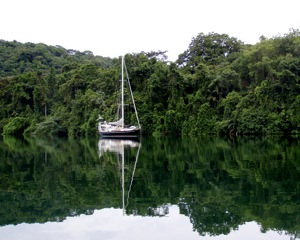
Continuing with Part 2 of this 3 part series on Outfitting a Cruising Boat. Part II is specific to sailing/cruising equipment. Be sure to check out yesterday’s post, Part I if you haven’t already seen it and don’t miss Part III, Outfitting for Lifestyle Cruising tomorrow!
SAILING/CRUISING EQUIPMENT . In addition to big amp consumers, think carefully through sailing/cruising equipment:
- Reefing from Cockpit – aboard Winterlude David has to go to the mast to reef the mainsail. I wish we had figured out a way to have reefing from the cockpit before we left to go cruising. Now we’re used to the drill, but it still makes me nervous having him up by the mast in conditions where we need to reef! Luckily Winterlude has bars on either side of the the mast for protection while up there.
- Self Steering – You’ll want reliable self steering and it’s not inexpensive. Be sure to get something robust or even oversize for your boat size and weight. The last thing you want is to be hand steering if you’re going any distance. Keep in mind, if there’s no wind, a wind vane isn’t reliable, so you’ll need a backup autopilot. We have a wheel pilot that came with the boat and a below decks robust autopilot for a total of three autopilots.
- Anchoring/Windlass/Anchor/Rode – Do you like to sleep at night? If you’re planning to anchor, this is one of the most important categories on the list. Be sure to choose wisely and do not be penny wise and pound foolish. Your primary anchor should probably be at least one size bigger than recommended, plus lots of chain, not just a boatlength. We have 150′ of chain and 150′ of 3 strand nylon rode on our primary anchor and we wish we had chosen all chain. Electric windlass? We had a very good manual windlass for the first 3 years but just before we left to go cruising, stories of boats that should have re-anchored but were tired and didn’t want to pull the anchor up again because it was too much physical effort with the result several lost boats because they didn’t reanchor, convinced us to add the electric windlass. We’re glad we did.
NAVIGATION EQUIPMENT. GPS, charts, electronic charts, AIS. Plan for multiple chart options just in case something happens to your primary charts. At a bare minimum you should have paper charts a GPS and a backup GPS. We currently have 4 GPS’ aboard, 2 of which are in use anytime we’re underway.
Don’t forget to read Part I, Outfitting a Cruising Boat and Part III tomorrow, Outfitting for Your Lifestyle!
What have I forgotten? Leave a comment & share with others! THX! Jan
RELATED ARTICLES MORE FROM AUTHOR

Baby, It’s COLD Inside! Keeping Warm on a Boat
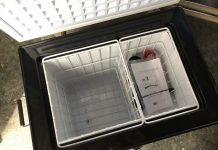
Need More Fridge Space? Try a Portable Refrigerator/Freezer

13 Additions to Optimystique
Thanks for this article. It was very helpful. I am currently looking for the right equipment for my boat. I will talk to my husband about it.
LEAVE A REPLY Cancel reply
Save my name, email, and website in this browser for the next time I comment.
Notify me of follow-up comments by email.
Notify me of new posts by email.
Currently you have JavaScript disabled. In order to post comments, please make sure JavaScript and Cookies are enabled, and reload the page. Click here for instructions on how to enable JavaScript in your browser.

Do We Really NEED Self-Steering?

The Infamous Nav-Pod Tool

Comparison of Bahamas Electronic Charts
- BOAT OF THE YEAR
- Newsletters
- Sailboat Reviews
- Boating Safety
- Sailing Totem
- Charter Resources
- Destinations
- Galley Recipes
- Living Aboard
- Sails and Rigging
- Maintenance

15 Tips for Buying a Sailboat
- By Peter Berman
- Updated: October 2, 2019
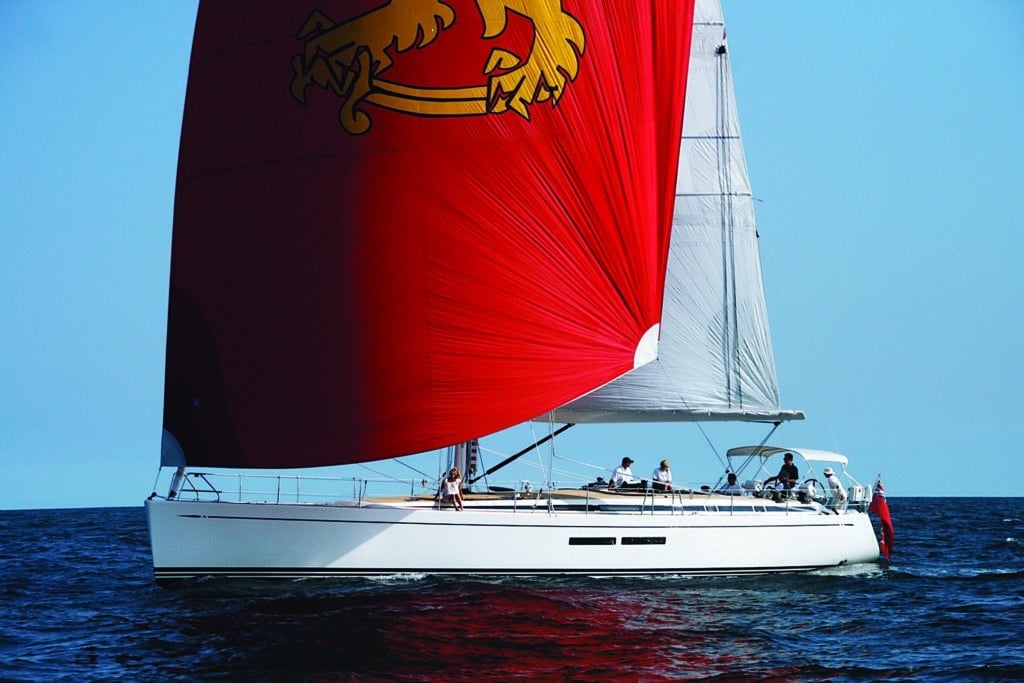
Run a dinghy around any major harbor in the world’s far-flung cruising grounds, and it’s quickly apparent that there’s no such thing as a “perfect” cruising boat. But if you’re in the market for buying a used sailboat or cruiser, the essentials are nearly universal for every sailor: You need a boat that you can readily afford (including the refit and/or outfitting), that meets your specific needs (depending on size of crew and intended itinerary) and that will be saleable afterward. Sure, high-end custom one-offs may be better constructed than “classic plastic” production boats, but that doesn’t necessarily translate into a better cruising experience . Need advice on how to buy a sailboat? Below are some sailboat buying tips divined from owning and sailing more than 100,000 miles in a dozen very different cruisers — from high-tech performance ocean racers to traditional split-rig wooden boats — over several decades.
Tip 1: Remember the 30:70 rule: The builder makes 30 percent of the boat and purchases the remaining 70 percent from other suppliers, almost all of which has to be periodically replaced at ever-higher prices. The 30:70 rule helps explain high rates of depreciation — typically 50 percent after the first decade and 75 percent after the second.
Tip 2: Focus on the total acquisition costs: the purchase price plus the inevitable refit. A good rule of thumb is to use only half the boat budget to buy the sailboat, then employ the other half for the requisite upgrades. A common boat-buying mistake is not reserving enough money for the overhaul. Also, prepare a realistic annual maintenance budget before the purchase. A boat stuck on the dock provides no joy.
Tip 3: Avoid being beguiled by a long list of equipment and cosmetic touch-ups. Fact: Most equipment will probably require replacement. Also, brokers and sellers know that cosmetics help sell boats, but they don’t make them sail any better. Similarly, view claims of a “recent refit” with skepticism. Does new anchor chain or new sails make the boat worth more when chain and sails are part of a boat’s normal complement of gear? (And that actually may be a “yes” when it comes to sails, but rarely will you find a used boat with a new inventory.)
Tip 4: The major refit costs will likely involve the rig and engine. After 15 to 20 years, it’s long past time to pull the mast, upgrade the standing rigging and terminals, take apart the spar and inspect for crevice corrosion and cracks, replace blocks, inspect the sheaves and mast step, and beef up gear as necessary. For extended offshore use, the general rule is to replace everything with heavier rigging and equipment. Losing a mast offshore makes for a very bad day. Paint makes masts look better but often hides corrosion.
Tip 5: Likewise, after two decades, it’s time to pay the “engine piper” — or pay him later. There are basically two options: rebuild what’s already installed (saving half the cost) or repower with a new engine. Typically, the in-and-out labor costs are equal to the cost of a rebuilt or new engine. Changing engine brands can significantly add to the price. Remember, many experienced cruisers cover as many as half their miles under power (especially those running up and down the Intracoastal Waterway). So a reliable engine is essential. No one ever complains when it starts up every time! Also, budget for ample spare parts; obtaining them in distant ports can be a real headache.
Tip 6: Nothing improves comfort more than size. Within limits, everything on the boat can be changed except size. But size is a double-edged sword, as costs and maintenance even in slightly larger boats are disproportionately higher. As size increases, so does volume. A 40-footer will have twice the volume of a 30-footer. When discussing size, focus on the waterline length. Length matters because size yields more storage space and more accommodations, and longer boats tend to sail faster, with a smoother motion. Bigger boats also provide the ability to take on additional crew for longer passages.
Tip 7: The boat’s gear is one of the most important factors to consider when buying a sailboat. With the right gear, including electric winches for furling mains or halyards, a senior couple in reasonably good condition can take a 60-footer offshore. But the maintenance and operating costs of such a vessel can approach six figures yearly. Most cruising is done in affordable vessels in the 40-foot range, where traditional gear gets the job done. All that said, when cruising really took off in the 1960s and 1970s, a 25-foot fiberglass production boat was often considered big enough for offshore work.
Tip 8: As mentioned at the outset, there’s no such thing as a perfect cruising boat, no matter how large the budget. Moreover, one’s notion of an ideal cruiser changes with experience, intended usage and age. Boats are always works in progress. Center cockpits with island double berths have nice accommodations for dockside use. For offshore sailing, on the other hand, and especially if they eschew island doubles for snug sea berths, aft cockpits enhance the sailing experience. Jib furlers and electric winches make life easier but also can introduce cost and maintenance issues. Everyone underestimates the cost of owning and operating a functioning cruising boat.
Tip 9: Beware of fancy joiner work and the liberal use of external teak. It’s nice to look at, but it doesn’t make the boat perform any better and is costly and/or time-consuming to own and maintain. Similarly, unless you have deep pockets, avoid teak decks. (Teak is lovely, but it’s also awfully hot in the tropics.) Whether screwed or glued, after 15 years, teak decks are typically ready for replacement, nowadays at a cost that would buy a nice cruising sailboat.
Tip 10: Given the choice, opt for a boat drawn by a reputable naval architect over one from a builder who designed his own boats. I’ve found that the collaborative efforts produce better boats. Pay special attention to designers and builders who focus on cruisers, not raceboats. When you’ve narrowed down a prospect, learn about the boat’s history, talk to owners of similar boats and experienced surveyors, and, when applicable, contact the club associations of respective models, which can be good sources of information. Whatever you’re considering, remember that a boat that’s “lived in the islands” is apt to have had a hard life.
Tip 11: If you’re truly considering long-range cruising, think long and hard about the boat’s accommodations for use offshore. Double berths in the bow or stern are wonderful in port, as are swivel chairs in the main saloon. Without functional sea berths amidships, however, the crew will wind up sleeping on the cabin floor and asking when the trip will be over. Any sea berth worthy of its name is a minimum of 7 feet long and has a proper lee cloth.
Tip 12: Like Napoleon’s armies, crews travel on their stomachs. Spacious galleys are fine alongside a dock, but at sea you need a galley where the cook is secure and the pots and pans stay off the cabin sole. If you really want to eat well offshore, nothing beats a large freezer or crews handy with a rod and reel.
Tip 13: Marine toilets can and do fail, usually at the most awkward time. Spares help, but a second head is better. Repairing a head when underway is probably the worst job afloat.
Tip 14: Regardless of your budget or the size of your vessel, take safety seriously. That means a certified ocean life raft, EPIRBs, SOLAS-rated and -equipped life jackets with harnesses, a VHF radio with AIS, ample bilge pumps and even a sat phone if voyaging offshore. Before loading up on electronics, cover the safety gear. Sure, it’s nice to have an SSB radio, a big-screen chart plotter, an autopilot, a TV, a Wi-Fi router and so on. But buy the life raft first — if not for yourself, then for your crew and loved ones (even if they’re not sailing with you).
Tip 15: When in doubt, walk away. Unless the boat inspires real passion, it’s the wrong boat. Find the most competent and highly regarded surveyor available. Ask him or her about the required refit and likely costs involved. I’ve never regretted walking away from, or spending the money on, a “problem” survey. Make sure you have a serious sea trial — and not just a short run with the engine, and a quick raising and lowering of sails — in a good breeze. Even very experienced sailors can fail to note the obvious on sea trials, especially rushed ones.
Looking back on the cruising boats I’ve owned, my favorite was a fiberglass 45-foot ketch built in the early 1970s with an aft cockpit, a centerboard and double headsails. It had none of the amenities we now take for granted (a small portable generator handled the “electrics”), yet we fairly scooted across the Pacific. Close behind was a 35-foot block-and-tackle wooden ketch built in the 1960s, with no winches. The larger boat is still going strong in the islands, the smaller one in Alaska. So that’s my final tip: You can sail a long way on a simple boat.
An engineer by training with over four decades of experience voyaging in the Atlantic, the Pacific and the Caribbean, Peter Berman is the author of Outfitting the Offshore Cruising Sailboat (Paradise Cay Publications, 2011).
Read about: Boat Buying | Sailboat Reviews
- More: boat buyer's guide , How To , Sailboats
- More How To
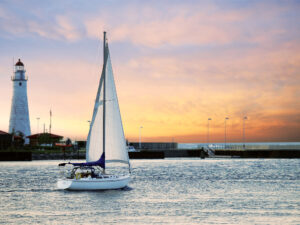
Preparing to Head Out
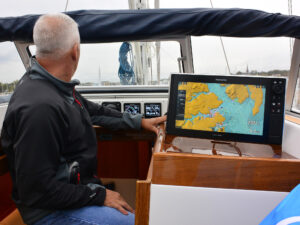
Adding Onboard Electronics? Here’s How To Get Started
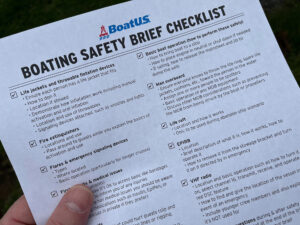
7 Boating Safety Tips for Summer Cruising
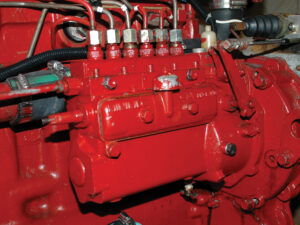
How to Prep for a Diesel You Can Depend On
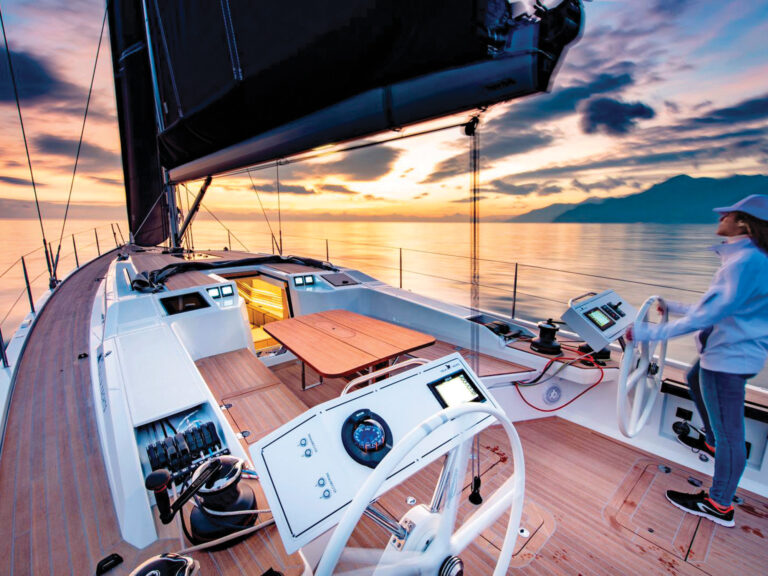
Sailboat Review: Italia Yachts 14.98
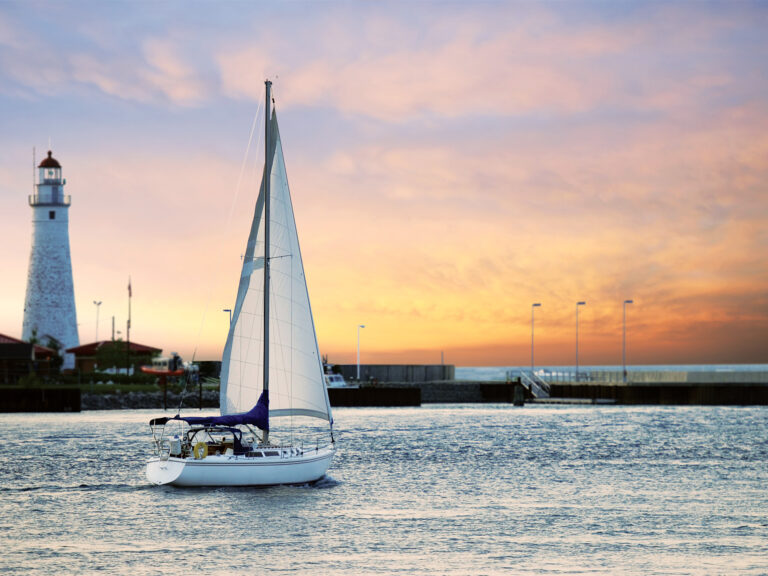
Competitive Cruising: It’s a Rally, Not a Race
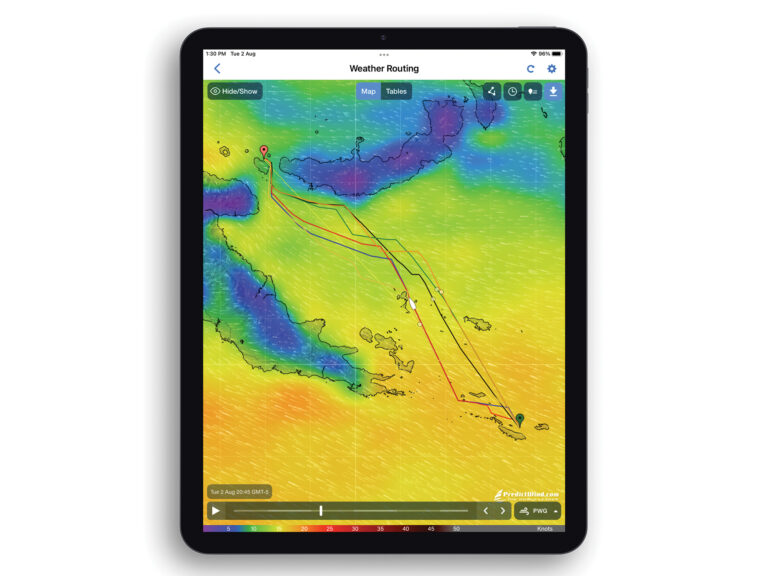
The Data Difference: Advances in Marine Weather Forecasting
- Digital Edition
- Customer Service
- Privacy Policy
- Email Newsletters
- Cruising World
- Sailing World
- Salt Water Sportsman
- Sport Fishing
- Wakeboarding

FREE shipping on $100+ Orders
You have no items in your shopping cart.
Enter Your Search Term Below
JavaScript seems to be disabled in your browser. You must have JavaScript enabled in your browser to utilize the functionality of this website.
Outfitting the Offshore Cruising Sailboat

Availability:
Be the first to review this product
PRICE
Description
Specifications, customer reviews.
Write your own review
There are currently no reviews for this product. Click the link above to write a review.
Write A Review
Only registered users can write reviews. Please, log in or register
There are currently no rebates available for this item
Related Products
Related accessories.

Spinlock Deckvest 6D HRS 170N Life Jacket
Regular Price: $409.00
Special Price $339.99

British Admiralty Region 9 Charts - North America (East Coast) and Caribbean

United States Coast Pilots

The Panama Guide 2nd Ed.

Charlie's Charts U.S. Pacific Coast 6th Ed.
You may also like

World Cruising Essentials

Waterproof Vinyl Chart KIt sleeves Weatherproof Cover 18" 24"

Maptech Paper Chart Kit Region 10 7th Ed.

ACR OLAS Crew Tag 4-Pack & Case

Mustang Minimalist Inflatable Belt Pack PFD
Regular Price: $109.99
Special Price $79.95
- Boats & Parts
- Gifts & Galley
- Training Center
The Navigator
- News & Articles
- Expert Advice
- Safety Alerts
- Shopping cart
- Customer Service
- Shipping Information
- Returns & Refunds
Retail Store
- 151 Harvard Avenue Stamford. CT 06902
- Driving Directions >
- Mon: CLOSED
- Tue: 9 AM - 5 PM
- Wed: 9 AM - 5 PM
- Thur: 9 AM - 5 PM
- Fri: 9 AM - 5 PM
- Sat: 9 AM - 3 PM
- Sun: CLOSED
- Toll Free (800) 941-2219
- Local (203) 487-0775
- Fax (203) 487- 0776
Apparel Deals

Privacy Policy | Terms of Use | Copyright 2024 Landfall Navigation. All Rights Reserved.

- Sports & Outdoors
- Water Sports

Enjoy fast, free delivery, exclusive deals, and award-winning movies & TV shows with Prime Try Prime and start saving today with fast, free delivery
Amazon Prime includes:
Fast, FREE Delivery is available to Prime members. To join, select "Try Amazon Prime and start saving today with Fast, FREE Delivery" below the Add to Cart button.
- Cardmembers earn 5% Back at Amazon.com with a Prime Credit Card.
- Unlimited Free Two-Day Delivery
- Streaming of thousands of movies and TV shows with limited ads on Prime Video.
- A Kindle book to borrow for free each month - with no due dates
- Listen to over 2 million songs and hundreds of playlists
- Unlimited photo storage with anywhere access
Important: Your credit card will NOT be charged when you start your free trial or if you cancel during the trial period. If you're happy with Amazon Prime, do nothing. At the end of the free trial, your membership will automatically upgrade to a monthly membership.
Buy new: .savingPriceOverride { color:#CC0C39!important; font-weight: 300!important; } .reinventMobileHeaderPrice { font-weight: 400; } #apex_offerDisplay_mobile_feature_div .reinventPriceSavingsPercentageMargin, #apex_offerDisplay_mobile_feature_div .reinventPricePriceToPayMargin { margin-right: 4px; } -29% $35.74 $ 35 . 74 FREE delivery Tuesday, June 4 Ships from: Amazon.com Sold by: Amazon.com
Return this item for free.
Free returns are available for the shipping address you chose. You can return the item for any reason in new and unused condition: no shipping charges
- Go to your orders and start the return
- Select the return method
Save with Used - Good .savingPriceOverride { color:#CC0C39!important; font-weight: 300!important; } .reinventMobileHeaderPrice { font-weight: 400; } #apex_offerDisplay_mobile_feature_div .reinventPriceSavingsPercentageMargin, #apex_offerDisplay_mobile_feature_div .reinventPricePriceToPayMargin { margin-right: 4px; } $28.17 $ 28 . 17 $3.98 delivery June 4 - 5 Ships from: glenthebookseller Sold by: glenthebookseller

Download the free Kindle app and start reading Kindle books instantly on your smartphone, tablet, or computer - no Kindle device required .
Read instantly on your browser with Kindle for Web.
Using your mobile phone camera - scan the code below and download the Kindle app.

Follow the author

Image Unavailable

- To view this video download Flash Player

The Modern Cruising Sailboat: A Complete Guide to its Design, Construction, and Outfitting Hardcover – Illustrated, November 27, 2009
Purchase options and add-ons.
A comprehensive guide to help you identify and equip the boat that best suits your needs
Well-known boating writer Charles Doane unravelsthe complexity of cruising sailboat design and explains the fundamentals and the ramifications of each design decision. In easy-to-understand terms, Doane explains theoreticalaspects of design, pragmatic issues like keel shapeand berth configuration, pros and cons of variousconstruction methods and materials, outfitting, propulsion,rigging and much more.
- Print length 400 pages
- Language English
- Publisher International Marine/Ragged Mountain Press
- Publication date November 27, 2009
- Dimensions 8.9 x 1.3 x 11.2 inches
- ISBN-10 0071478108
- ISBN-13 978-0071478106
- See all details

Frequently bought together

Customers who viewed this item also viewed

Editorial Reviews
From the publisher, about the author, excerpt. © reprinted by permission. all rights reserved., the modern cruising sailboat, the mcgraw-hill companies, inc., chapter one.
Excerpted from THE MODERN CRUISING SAILBOAT by CHARLES J. DOANE Copyright © 2010 by Charles J. Doane. Excerpted by permission of The McGraw-Hill Companies, Inc.. All rights reserved. No part of this excerpt may be reproduced or reprinted without permission in writing from the publisher. Excerpts are provided by Dial-A-Book Inc. solely for the personal use of visitors to this web site.
Product details
- Publisher : International Marine/Ragged Mountain Press; 1st edition (November 27, 2009)
- Language : English
- Hardcover : 400 pages
- ISBN-10 : 0071478108
- ISBN-13 : 978-0071478106
- Item Weight : 2.67 pounds
- Dimensions : 8.9 x 1.3 x 11.2 inches
- #802 in Sailing (Books)
- #973 in Boating (Books)
About the author
Charles j. doane.
Discover more of the author’s books, see similar authors, read author blogs and more
Customer reviews
Customer Reviews, including Product Star Ratings help customers to learn more about the product and decide whether it is the right product for them.
To calculate the overall star rating and percentage breakdown by star, we don’t use a simple average. Instead, our system considers things like how recent a review is and if the reviewer bought the item on Amazon. It also analyzed reviews to verify trustworthiness.
- Sort reviews by Top reviews Most recent Top reviews
Top reviews from the United States
There was a problem filtering reviews right now. please try again later..
Top reviews from other countries
- Amazon Newsletter
- About Amazon
- Accessibility
- Sustainability
- Press Center
- Investor Relations
- Amazon Devices
- Amazon Science
- Sell on Amazon
- Sell apps on Amazon
- Supply to Amazon
- Protect & Build Your Brand
- Become an Affiliate
- Become a Delivery Driver
- Start a Package Delivery Business
- Advertise Your Products
- Self-Publish with Us
- Become an Amazon Hub Partner
- › See More Ways to Make Money
- Amazon Visa
- Amazon Store Card
- Amazon Secured Card
- Amazon Business Card
- Shop with Points
- Credit Card Marketplace
- Reload Your Balance
- Amazon Currency Converter
- Your Account
- Your Orders
- Shipping Rates & Policies
- Amazon Prime
- Returns & Replacements
- Manage Your Content and Devices
- Recalls and Product Safety Alerts
- Conditions of Use
- Privacy Notice
- Consumer Health Data Privacy Disclosure
- Your Ads Privacy Choices
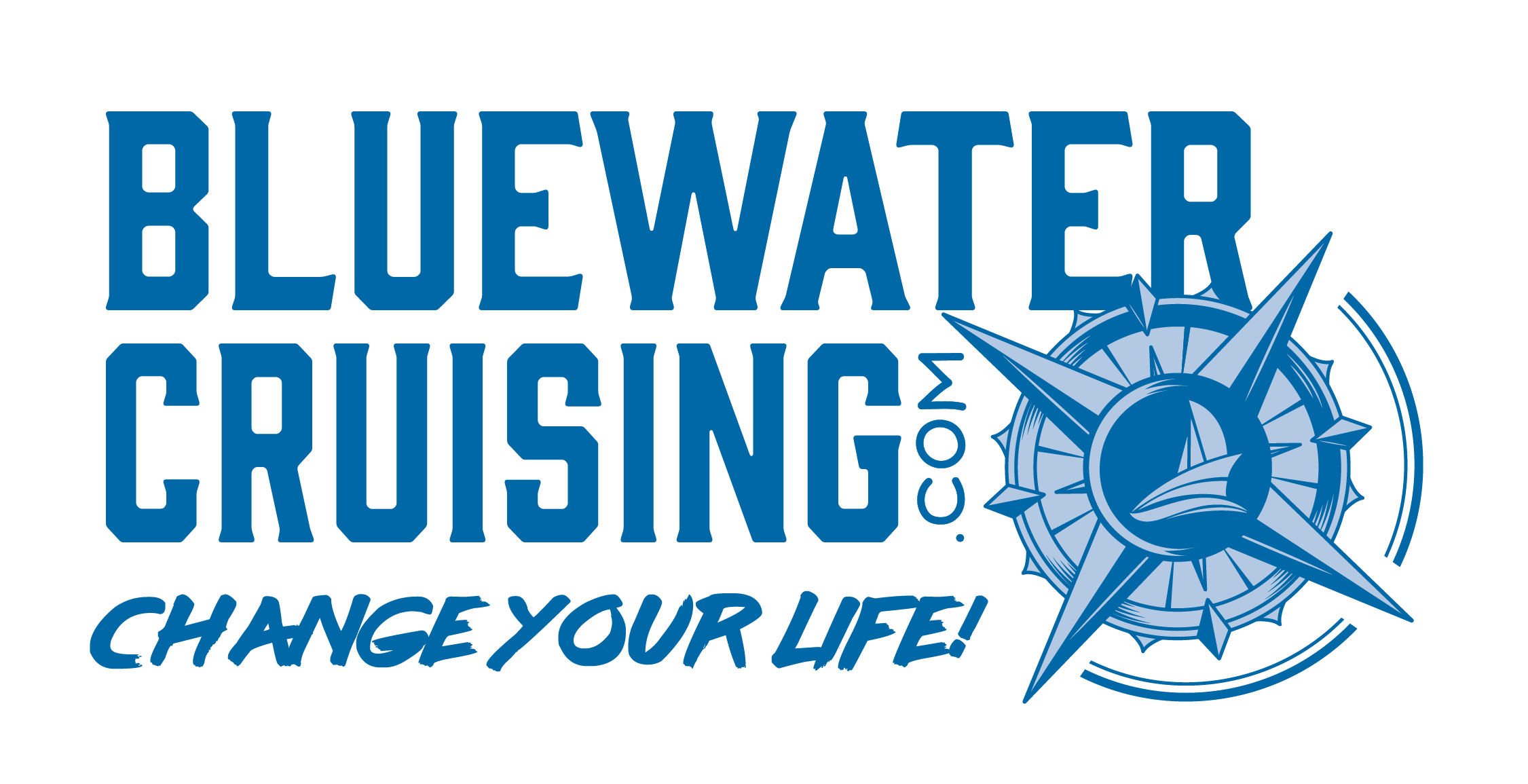
- Bluewater Boat Insurance
- Member Success
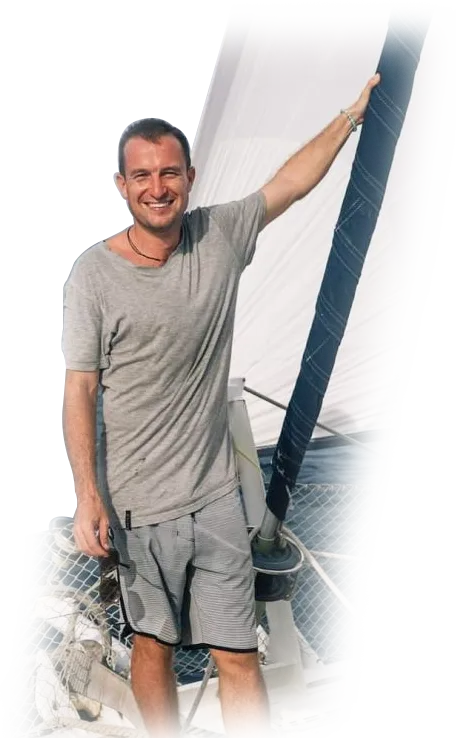
Go through your journey to Bluewater Cruising with our industry leading training programs. Learning how to sail is only 10% of what it takes to change your life and go cruising. We teach the other 90%.
Check out our live, interactive, premium course. Click Learn more to view the details.
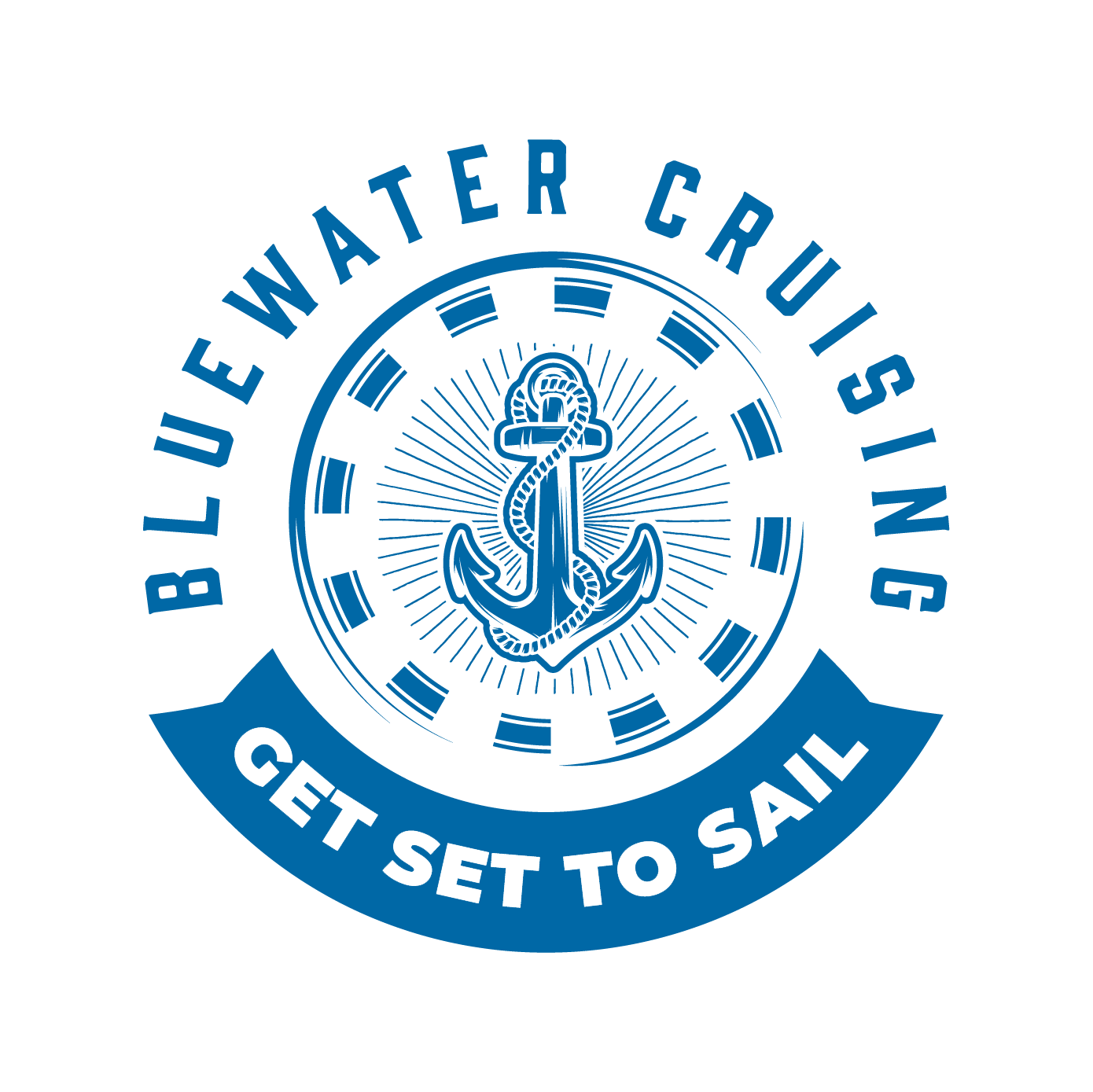
Get Set To Sail
Live (online).
Jumpstart your journey to Bluewater Cruising with our flagship program
that covers everything from boat buying, outfitting, finances, maintenance,
weather, liveaboard secrets, route planning and much more.
BLUEWATER CRUISING
Compass call.
Let’s hop on a Quick 1 on 1 Compass Call where we can hash out your top 3 challenges to getting started Bluewater Cruising and get you pointed in the right direction. (It’s Free)
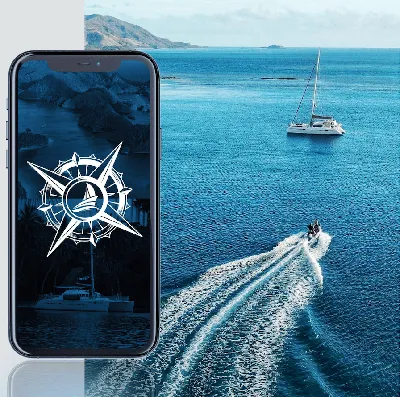
Let’s hop on a quick 1 on 1 Compass call where we can hash out your top 3 challenges to getting started Bluewater Cruising and get you pointed in the right direction. (It’s Free)

© 2024 Bluewater Cruising All Rights Reserved
Privacy Notice | Disclaimer | Terms of Use
- CruiseMapper
- Cruise news
- Cruise Industry
- Ritz-Carlton's ship Ilma completes sea trials ahead of September...
Ritz-Carlton's ship Ilma completes sea trials ahead of September debut
Ritz-Carlton 's second superyacht completed sea trials on May 20th, off the coast of France in the Bay of Biscay.
Constructed by the French shipbuilder Chantiers de l’Atlantique/STX France in St-Nazaire , the new ship - named Ilma , is scheduled to enter service in September 2024.
Designed by Helsinki -based design studio Aivan, Ilma features a sleek and graceful exterior inspired by private superyacht aesthetics, setting it apart from typical cruise vessels. Construction commenced with the keel-laying in March 2023, followed by the float out in September 2023. Ilma is one of two ships ordered from the French shipyard, with her sistership, Luminara , expected to enter service in 2025.
The ultra-luxury travel brand Ritz-Carlton Yacht Collection, launched by an investor group under a licensed brand name, introduced its first Spain-built ship, Evrima launched in 2023 after several delays. This move is part of a broader industry trend, with luxury hotel brands like Four Seasons and Orient Express also venturing into the ultra-luxury cruise segment.
Ilma and Luminara are larger and more traditionally designed compared to Evrima. Ilma's volume is 46,750 GT-tons. The vessel has LOA length 790 ft (241 m), max passenger capacity 448 ( 224 suites ) plus 374 crew, 10 decks (6 with cabins).
In contrast, Evrima is 25,400 gross tons and holds 298 passengers in 149 suites.
The sea trials for Ilma, conducted between May 16 and 20, tested the ship’s seakeeping, noise, vibration, and wind comfort. The ship will now undergo final outfitting and a last trial before her maiden voyage on September 2, 2024, from Monte Carlo to Rome.
Watch CBS News
He fell ill on a cruise. Before he boarded the rescue boat, they handed him the bill.
By Bram Sable-Smith
Updated on: May 24, 2024 / 6:33 PM EDT / KFF Health News
Vincent Wasney and his fiancée, Sarah Eberlein, had never visited the ocean. They'd never even been on a plane. But when they bought their first home in Saginaw, Michigan, in 2018, their real estate agent gifted them tickets for a Royal Caribbean cruise.
After two years of delays due to the coronavirus pandemic, they set sail in December 2022.
The couple chose a cruise destined for the Bahamas in part because it included a trip to CocoCay, a private island accessible to Royal Caribbean passengers that featured a water park, balloon rides and an excursion swimming with pigs.
It was on that day on CocoCay when Wasney, 31, started feeling off, he said.
The next morning, as the couple made plans in their cabin for the last full day of the trip, Wasney made a pained noise. Eberlein saw him having a seizure in bed, with blood coming out of his mouth from biting his tongue. She opened their door to find help and happened upon another guest, who roused his wife, an emergency room physician.
Wasney was able to climb into a wheelchair brought by the ship's medical crew to take him down to the medical facility, where he was given anticonvulsants and fluids and monitored before being released.
Wasney had had seizures in the past, starting about 10 years ago, but it had been a while since his last one. Imaging back then showed no tumors, and doctors concluded he was likely epileptic, he said. He took medicine initially, but after two years without another seizure, he said, his doctors took him off the medicine to avoid liver damage.

Wasney had a second seizure on the ship a few hours later, back in his cabin. This time he stopped breathing, and Eberlein remembered his lips being so purple, they almost looked black. Again, she ran to find help but, in her haste, locked herself out. By the time the ship's medical team got into the cabin, Wasney was breathing again but had broken blood vessels along his chest and neck that he later said resembled tiger stripes.
Wasney was in the ship's medical center when he had a third seizure — a grand mal, which typically causes a loss of consciousness and violent muscle contractions. By then, the ship was close enough to port that Wasney could be evacuated by rescue boat. He was put on a stretcher to be lowered by ropes off the side of the ship, with Eberlein climbing down a rope ladder to join him.
But before they disembarked, the bill came.
The Patient: Vincent Wasney, 31, who was uninsured at the time.
Medical Services: General and enhanced observation, a blood test, anticonvulsant medicine, and a fee for services performed outside the medical facility.
Service Provider: Independence of the Seas Medical Center, the on-ship medical facility on the cruise ship operated by Royal Caribbean International .
Total Bill: $2,500.22.
What Gives: As part of Royal Caribbean's guest terms , cruise passengers "agree to pay in full" all expenses incurred on board by the end of the cruise, including those related to medical care. In addition, Royal Caribbean does not accept "land-based" health insurance plans.
Wasney said he was surprised to learn that, along with other charges like wireless internet, Royal Caribbean required he pay his medical bills before exiting the ship — even though he was being evacuated urgently.
"Are we being held hostage at this point?" Eberlein remembered asking. "Because, obviously, if he's had three seizures in 10 hours, it's an issue."
Wasney said he has little memory of being on the ship after his first seizure — seizures often leave victims groggy and disoriented for a few hours afterward.
But he certainly remembers being shown a bill, the bulk of which was the $2,500.22 in medical charges, while waiting for the rescue boat.
Still groggy, Wasney recalled saying he couldn't afford that and a cruise employee responding: "How much can you pay?"
They drained their bank accounts, including money saved for their next house payment, and maxed out Wasney's credit card but were still about $1,000 short, he said.
Ultimately, they were allowed to leave the ship. He later learned his card was overdrafted to cover the shortfall, he said. Once on land, in Florida, Wasney was taken by ambulance to the emergency room at Broward Health Medical Center in Fort Lauderdale, where he incurred thousands of dollars more in medical expenses.
He still isn't entirely sure what caused the seizures.
On the ship he was told it could have been extreme dehydration — and he said he does remember being extra thirsty on CocoCay. He also has mused whether trying escargot for the first time the night before could have played a role. Eberlein's mother is convinced the episode was connected to swimming with pigs, he said. And not to be discounted, Eberlein accidentally broke a pocket mirror three days before their trip.
Wasney, who works in a stone shop, was uninsured when they set sail. He said that one month before they embarked on their voyage, he finally felt he could afford the health plan offered through his employer and signed up, but the plan didn't start until January 2023, after their return.
They also lacked travel insurance. As inexperienced travelers, Wasney said, they thought it was for lost luggage and canceled trips, not unexpected medical expenses. And because the cruise was a gift, they were never prompted to buy coverage, which often happens when tickets are purchased.

The Resolution: Wasney said the couple returned to Saginaw with essentially no money in their bank account, several thousand dollars of medical debt, and no idea how they would cover their mortgage payment. Because he was uninsured at the time of the cruise, Wasney did not try to collect reimbursement for the cruise bill from his new health plan when his coverage began weeks later.
The couple set up payment plans to cover the medical bills for Wasney's care after leaving the ship: one each with two doctors he saw at Broward Health, who billed separately from the hospital, and one with the ambulance company. He also made payments on a bill with Broward Health itself. Those plans do not charge interest.
But Broward Health said Wasney missed two payments to the hospital, and that bill was ultimately sent to collections.
In a statement, Broward Health spokesperson Nina Levine said Wasney's bill was reduced by 73% because he was uninsured.
"We do everything in our power to provide the best care with the least financial impact, but also cannot stress enough the importance of taking advantage of private and Affordable Care Act health insurance plans, as well as travel insurance, to lower risks associated with unplanned medical issues," she said.
The couple was able to make their house payment with $2,690 they raised through a GoFundMe campaign that Wasney set up. Wasney said a lot of that help came from family as well as friends he met playing disc golf, a sport he picked up during the pandemic.
"A bunch of people came through for us," Wasney said, still moved to tears by the generosity. "But there's still the hospital bill."
The Takeaway: Billing practices differ by cruise line, but Joe Scott , chair of the cruise ship medicine section of the American College of Emergency Physicians, said medical charges are typically added to a cruise passenger's onboard account, which must be paid before leaving the ship. Individuals can then submit receipts to their insurers for possible reimbursement.
He recommended that those planning to take a cruise purchase travel insurance that specifically covers their trips. "This will facilitate reimbursement if they do incur charges and potentially cover a costly medical evacuation if needed," Scott said.
Royal Caribbean suggests that passengers who receive onboard care submit their paid bills to their health insurer for possible reimbursement. Many health plans do not cover medical services received on cruise ships, however. Medicare will sometimes cover medically necessary health care services on cruise ships, but not if the ship is more than six hours away from a U.S. port.
Travel insurance can be designed to address lots of out-of-town mishaps , like lost baggage or even transportation and lodging for a loved one to visit if a traveler is hospitalized.
Travel medical insurance, as well as plans that offer "emergency evacuation and repatriation," are two types that can specifically assist with medical emergencies. Such plans can be purchased individually. Credit cards may offer travel medical insurance among their benefits, as well.
But travel insurance plans come with limitations. For instance, they may not cover care associated with preexisting conditions or what the plans consider "risky" activities, such as rock climbing. Some plans also require that travelers file first with their primary health insurance before seeking reimbursement from travel insurance.
As with other insurance, be sure to read the fine print and understand how reimbursement works.
Wasney said that's what they plan to do before their next Royal Caribbean cruise. They'd like to go back to the Bahamas on basically the same trip, he said — there's a lot about CocoCay they didn't get to explore.
Bill of the Month is a crowdsourced investigation by KFF Health News and NPR that dissects and explains medical bills.
More from CBS News

Home prices reach $387,600 record high, putting a damper on spring

Many Americans are wrong about economic trends. Test your knowledge here.

Frontier CEO claims passengers are abusing wheelchair services

Want to lock in the best mortgage rate this month? Do these 6 things now
- Skip to main content
- Keyboard shortcuts for audio player
- Your Health
- Treatments & Tests
- Health Inc.
- Public Health
Bill Of The Month
He fell ill on a cruise. before he boarded the rescue boat, they handed him the bill.
Bram Sable-Smith

On the last full day of a Bahamas excursion, Vincent Wasney had three epileptic seizures. While being evacuated, he received a bill for expenses incurred during the cruise. Kristen Norman for KFF Health News hide caption
On the last full day of a Bahamas excursion, Vincent Wasney had three epileptic seizures. While being evacuated, he received a bill for expenses incurred during the cruise.
Vincent Wasney and his fiancée, Sarah Eberlein, had never visited the ocean. They'd never even been on a plane. But when they bought their first home in Saginaw, Michigan, in 2018, their real estate agent gifted them tickets for a Royal Caribbean cruise.
After two years of delays due to the coronavirus pandemic, they set sail in December 2022.
The couple chose a cruise destined for the Bahamas in part because it included a trip to CocoCay, a private island accessible to Royal Caribbean passengers that featured a water park, balloon rides, and an excursion swimming with pigs.
Bill of the Month is a crowdsourced investigation by KFF Health News and NPR that dissects and explains medical bills. Do you have an interesting medical bill you want to share with us? Tell us about it !
It was on that day on CocoCay when Wasney, 31, started feeling off, he said.
The next morning, as the couple made plans in their cabin for the last full day of the trip, Wasney made a pained noise. Eberlein saw him having a seizure in bed, with blood coming out of his mouth from biting his tongue. She opened their door to find help and happened upon another guest, who roused his wife, an emergency room physician.
Wasney was able to climb into a wheelchair brought by the ship's medical crew to take him down to the medical facility, where he was given anticonvulsants and fluids and monitored before being released.
Vincent had had seizures in the past, starting about ten years ago, but it had been a while since his last one. Imaging back then showed no tumors, and doctors concluded he was likely epileptic, he said. He took medicine initially, but after two years without another seizure, he said his doctors took him off the medicine to avoid liver damage.
Wasney had a second seizure on the ship a few hours later, back in his cabin. This time he stopped breathing, and Eberlein remembered his lips being so purple, they almost looked black. Again, she ran to find help but, in her haste, locked herself out. By the time the ship's medical team got into the cabin, Wasney was breathing again but had broken blood vessels along his chest and neck that he later said resembled tiger stripes.
Wasney was in the ship's medical center when he had a third seizure — a grand mal, which typically causes a loss of consciousness and violent muscle contractions. By then, the ship was close enough to port that Wasney could be evacuated by rescue boat. He was put on a stretcher to be lowered by ropes off the side of the ship, with Eberlein climbing down a rope ladder to join him.
But before they disembarked, the bill came.
The patient: Vincent Wasney, 31, who was uninsured at the time.
Medical services: General and enhanced observation, a blood test, anticonvulsant medicine, and a fee for services performed outside the medical facility.
Service provider: Independence of the Seas Medical Center, the on-ship medical facility on the cruise ship operated by Royal Caribbean International .
Total bill: $2,500.22.

Shots - Health News
A mom's $97,000 question: how was an air-ambulance ride not medically necessary.
What gives: As part of Royal Caribbean's guest terms , cruise passengers "agree to pay in full" all expenses incurred on board by the end of the cruise, including those related to medical care. In addition, Royal Caribbean does not accept "land-based" health insurance plans.
Wasney said he was surprised to learn that, along with other charges like wireless internet, Royal Caribbean required he pay his medical bills before exiting the ship — even though he was being evacuated urgently.
"Are we being held hostage at this point?" Eberlein remembered asking. "Because, obviously, if he's had three seizures in 10 hours, it's an issue."
Wasney said he has little memory of being on the ship after his first seizure — seizures often leave victims groggy and disoriented for a few hours afterward.
But he certainly remembers being shown a bill, the bulk of which was the $2,500.22 in medical charges, while waiting for the rescue boat.
Still groggy, Wasney recalled saying he couldn't afford that and a cruise employee responding: "How much can you pay?"
They drained their bank accounts, including money saved for their next house payment, and maxed out Wasney's credit card but were still about $1,000 short, he said.
Ultimately, they were allowed to leave the ship. He later learned his card was overdrafted to cover the shortfall, he said.
Royal Caribbean International did not respond to multiple inquiries from KFF Health News.
Once on land, in Florida, Wasney was taken by ambulance to the emergency room at Broward Health Medical Center in Fort Lauderdale, where he incurred thousands of dollars more in medical expenses.
He still isn't entirely sure what caused the seizures.
On the ship he was told it could have been extreme dehydration — and he said he does remember being extra thirsty on CocoCay. He also has mused whether trying escargot for the first time the night before could have played a role. Eberlein's mother is convinced the episode was connected to swimming with pigs, he said. And not to be discounted, Eberlein accidentally broke a pocket mirror three days before their trip.
Wasney, who works in a stone shop, was uninsured when they set sail. He said that one month before they embarked on their voyage, he finally felt he could afford the health plan offered through his employer and signed up, but the plan didn't start until January 2023, after their return.
They also lacked travel insurance. As inexperienced travelers, Wasney said, they thought it was for lost luggage and canceled trips, not unexpected medical expenses. And because the cruise was a gift, they were never prompted to buy coverage, which often happens when tickets are purchased.

When a quick telehealth visit yields multiple surprises beyond a big bill
The resolution: Wasney said the couple returned to Saginaw with essentially no money in their bank account, several thousand dollars of medical debt, and no idea how they would cover their mortgage payment. Because he was uninsured at the time of the cruise, Wasney did not try to collect reimbursement for the cruise bill from his new health plan when his coverage began weeks later.
The couple set up payment plans to cover the medical bills for Wasney's care after leaving the ship: one each with two doctors he saw at Broward Health, who billed separately from the hospital, and one with the ambulance company. He also made payments on a bill with Broward Health itself. Those plans do not charge interest.
But Broward Health said Wasney missed two payments to the hospital, and that bill was ultimately sent to collections.
In a statement, Broward Health spokesperson Nina Levine said Wasney's bill was reduced by 73% because he was uninsured.
"We do everything in our power to provide the best care with the least financial impact, but also cannot stress enough the importance of taking advantage of private and Affordable Care Act health insurance plans, as well as travel insurance, to lower risks associated with unplanned medical issues," she said.
The couple was able to make their house payment with $2,690 they raised through a GoFundMe campaign that Wasney set up. Wasney said a lot of that help came from family as well as friends he met playing disc golf, a sport he picked up during the pandemic.
"A bunch of people came through for us," Wasney said, still moved to tears by the generosity. "But there's still the hospital bill."
The takeaway: Billing practices differ by cruise line, but Joe Scott , chair of the cruise ship medicine section of the American College of Emergency Physicians, said medical charges are typically added to a cruise passenger's onboard account, which must be paid before leaving the ship. Individuals can then submit receipts to their insurers for possible reimbursement.
He recommended that those planning to take a cruise purchase travel insurance that specifically covers their trips. "This will facilitate reimbursement if they do incur charges and potentially cover a costly medical evacuation if needed," Scott said.
Royal Caribbean suggests that passengers who receive onboard care submit their paid bills to their health insurer for possible reimbursement. Many health plans do not cover medical services received on cruise ships, however. Medicare will sometimes cover medically necessary health care services on cruise ships, but not if the ship is more than six hours away from a U.S. port.
Travel insurance can be designed to address lots of out-of-town mishaps, like lost baggage or even transportation and lodging for a loved one to visit if a traveler is hospitalized.
Travel medical insurance, as well as plans that offer "emergency evacuation and repatriation," are two types that can specifically assist with medical emergencies. Such plans can be purchased individually. Credit cards may offer travel medical insurance among their benefits, as well.
But travel insurance plans come with limitations. For instance, they may not cover care associated with preexisting conditions or what the plans consider "risky" activities, such as rock climbing. Some plans also require that travelers file first with their primary health insurance before seeking reimbursement from travel insurance.
As with other insurance, be sure to read the fine print and understand how reimbursement works.
Wasney said that's what they plan to do before their next Royal Caribbean cruise. They'd like to go back to the Bahamas on basically the same trip, he said — there's a lot about CocoCay they didn't get to explore.
Emmarie Huetteman of KFF Health News edited the digital story, and Taunya English of KFF Health News edited the audio story. NPR's Will Stone edited the audio and digital story.
KFF Health News , formerly known as Kaiser Health News (KHN), is a national newsroom that produces in-depth journalism about health issues and is one of the core operating programs at KFF — the independent source for health policy research, polling, and journalism.
- medical bills
- broward health
- travel insurance
- cruise ship
- royal caribbean
First cruise ship sets sail from Port of…
Share this:.
- Click to share on Facebook (Opens in new window)
- Click to share on Twitter (Opens in new window)
Baltimore Sun eNewspaper
- Latest Headlines
- News Obituaries
- Death Notices
- Things To Do
First cruise ship sets sail from Port of Baltimore since Key Bridge collapse: ‘It’s a good day’

The festive occasion marked the first cruise ship to arrive and depart the Port of Baltimore since the collapse of the Francis Scott Key Bridge on March 26.
Less than a week prior, the terminal was the headquarters for the Key Bridge Response Unified Command to coordinate recovery operations, Daniels said. They began condensing their workspace down last weekend, started packing up Monday night after the Dali was refloated that morning and were out by Tuesday afternoon.

“While there is still work that needs to be done to be able to complete the salvage operation, this is a wonderful sign that the next milestone is pointing to the fact that business is truly returning to the port,” Daniels said.
Just after 10 a.m., the sound of steel drums echoed in the terminal as it began to fill with passengers eager to board Royal Caribbean’s Vision of the Seas cruise ship for a five-night trip to Bermuda.
Tom Sitzler said he and his group had planned the trip since August to celebrate his partner’s 60th birthday. They live in Washington, D.C., but had a very specific reason to sail out of the Port of Baltimore.
“The whole purpose of the cruise though was to actually cruise out of Baltimore out past Annapolis, because Allen grew up there, the birthday boy, and he wants to see Annapolis from the bay,” Sitzler said.
“I’ve always wanted to cruise down the bay and see all the spots where I grew up,” said Allen Steven, the birthday boy.
Cruises that were already underway or were scheduled in the past two months have been rerouted to the Norfolk Cruise Terminal . Steven said if their trip had been moved to leave from Norfolk, they would have rebooked.
A group of five friends from Harford County also were heading on a cruise to celebrate, donning matching pink hats that said “Friends on the Loose 2024 Friends Trip.”
“We are celebrating a milestone birthday,” said Kathy Schlehr. “We have all attained the age of 70 or beyond.”
“Not yet!” someone chimed in.
The group said they were ecstatic when they found out about a week and a half ago they would be sailing out of the Port of Baltimore. The departure location was one of the reasons they went on the cruise.
The return of cruises benefits the tourism industry in Baltimore and the rest of the state, Daniels said.

More than 440,000 passengers went through the Cruise Maryland Terminal in 2023, he said, and they may also stay in hotels, eat at restaurants and even come back to enjoy the city afterward.
“Many of them are experiencing what Baltimore has to offer for the very first time,” Daniels said.
The 915-foot long vessel with a 25-foot draft got underway after 4 p.m. and used the 400-foot-wide, 50-foot-deep channel that opened Tuesday in the Patapsco River. In addition to a pilot, it was accompanied by two tugboats.
Even though the Unified Command vacated the cruise terminal, operations are still ongoing, just back in their own spaces, said David O’Connell, the Coast Guard’s captain of the port. They coordinate daily on ongoing operations, including salvage work in the main and outside channels as well as coordinating with the Army Corps of Engineers on vessel traffic in the temporary channels.
Saturday, the Army Corps announced a delayed goal of June 8-10 to restore full access to the federal channel. Officials had previously said this would be achieved by the end of May.
“It was great all being together and coordinating operations, but it’s great to be here and see this place in a different light,” O’Connell said. “You see it lively with people that are going on vacation, going through security, the ship is out back. It’s a good day.”
More in News

17-year-old dead in double shooting in West Baltimore, police say

Crime and Public Safety | Attorney general’s office investigating Friday shooting where Baltimore officer injured, man fatally shot

Carroll County Times | Five people arrested, charged in couple’s kidnapping in Westminster, police say

News | Key Bridge collapse: Opening of federal channel delayed, set to open by June 10 at the latest
- My View My View
- Following Following
- Saved Saved
Two dead, five missing after boat collision on Danube in Hungary
- Medium Text
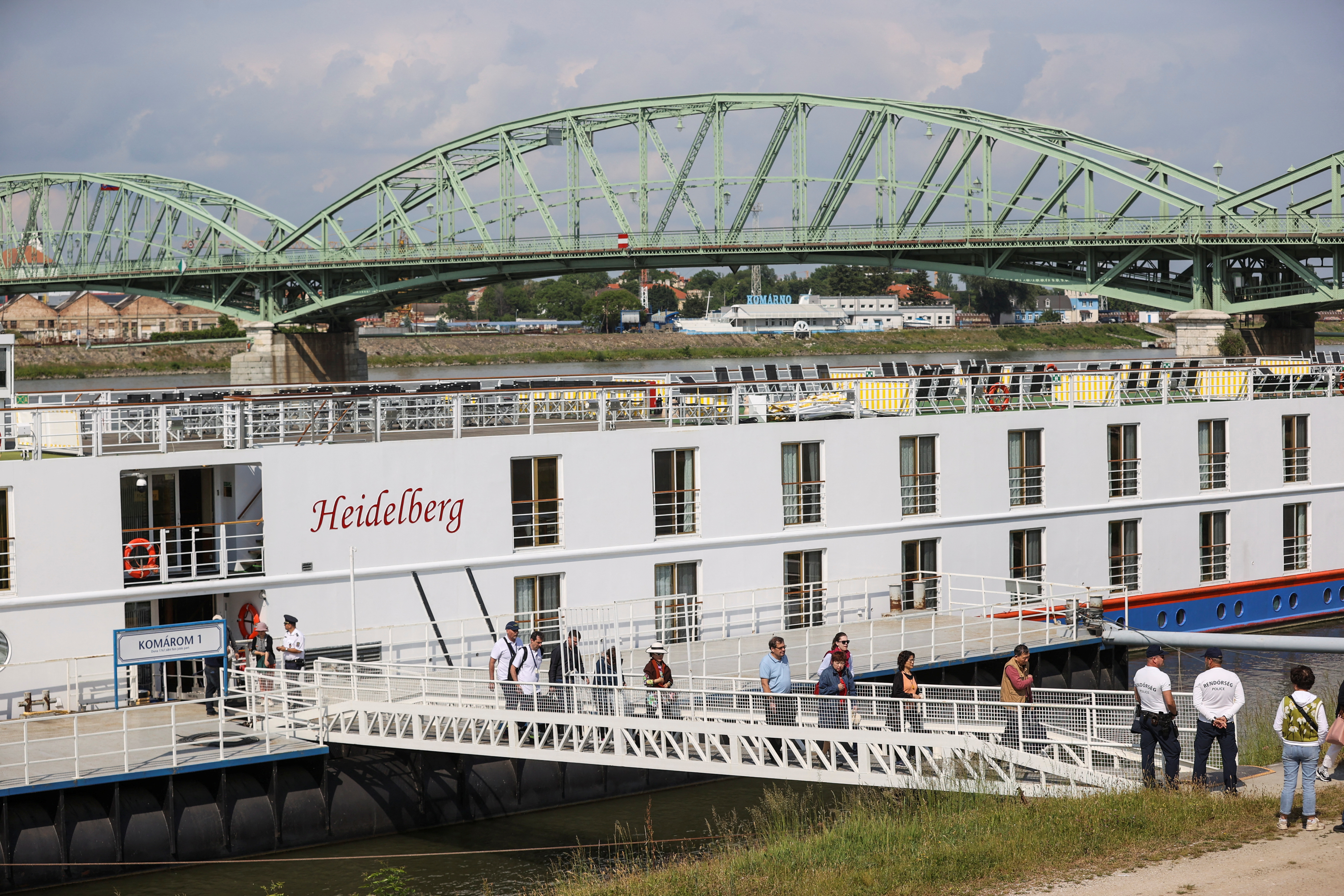
- Small motor boat collides with cruise ship -police
- 95 personnel, 25 ships deployed to search for survivors
- Reuters footage shows some damage to bow of cruise ship
Sign up here.
Reporting by Gergely Szakacs amd Krisztina Fenyo Editing by David Goodman and Susan Fenton
Our Standards: The Thomson Reuters Trust Principles. New Tab , opens new tab

Thomson Reuters
Gergely reports on central European economics, central banking and government policy, with content usually appearing on the Macro Matters, Markets, Business and World sections of the website. He has nearly two decades' worth of experience in financial journalism at Reuters and holds advanced degrees in English and Communication.

Lithuania holds presidential elections on Sunday, with incumbent Gitanas Nauseda expected to win after a campaign dominated by security concerns in the post-Soviet state.

World Chevron
Macron heads to germany in first french presidential state visit in 24 years.
French President Emanuel Macron lands in Germany on Sunday for a three-day state visit followed by a bilateral cabinet meeting as the European Union's two biggest powers seek to show unity ahead of next month's EU parliamentary elections.


IMAGES
VIDEO
COMMENTS
1. Sonic Anti-Fouling. A sonic anti-fouling system will work on steel, aluminum and fiberglass hulls, but not on wooden hulls. This unit, which fits on the inside of the hull, pulses an ultrasonic frequency. This electronic system keeps the worst of marine growth off hulls, leaving a film of fine slime only.
When cruising sailors talk about fitting out their boats for adventures on the high seas, the focus usually seems to be on big ticket items or creature comforts: a new dinghy and outboard, rigging, refrigeration, self-steering, wind and solar, etc. But there are a handful of safety considerations to take into account when preparing your boat ...
From Sailing Quarterly: Seamanship Vol. 2With well thoughts out solutions and a keen eye for detail Frank Butler has outfitted his liveaboard boat for troubl...
The Cruising Dream Mini Series - Episode 2This is a special mini series where I try and break down common questions I get for people who are just getting int...
Going cruising and leaving the dry-land world behind for weeks, months or years, is a lifetime opportunity. Outfitting your boat right is critical to passagemaking that is both safe and fun. ... and no more than 65 percent of the foretriangle height. Sailmakers with extensive cruising boat experience (Carol Hasse at Port Townsend Sails is an ...
The role your boat plays changes. First off, it really depends whether you're planning an ocean passage or just a long trip on lakes. If you stay inland, you need less equipment. For bluewater cruising, the change is the biggest. All of a sudden your boat is a liveaboard boat. On long cruising trips, you need to be self-reliant.
of the same age but will cost far less than outfitting an older boat that has only coastal equipment aboard. Overall Budget for Boat Purchase: Boat Purchase: 60% Outfitting: 40% Outfitting Cost: You'll likely need an additional $20,000 to $50,000 for necessary offshore equipment including storm sails, liferaft, windvane or
Here are 10 essential items for outfitting your sailboat for long-term cruising that no sailor should be without. 1. Anchor. The first and most important item on the list is a quality anchor and chain. A good anchor is essential for sleeping well at anchor, and it's important that it is strong enough to hold in a variety of conditions.
Outfit Your Cruising Boat: Life Aboard. Cruising the San Blas Islands, Panama. If you're a commuter cruiser, you are not camping, this boat is your home and most cruisers that we know that are happy cruising have "homes" not "campsites". I know there's so much to think about, but don't shortchange outfitting for your lifestyle.
Outfitting the Ideal Cruising Sailboat. By Sailing Quarterly producers, Rob and Dee Dubin. After filming Sailing Quarterly Video Magazine for 6 years and 24 episodes, the Dubin's purchased a new bluewater cruising boat, "Ventana" - an Island Packet 40. They outfitted her with many of the gear and customizations featured in the series.
Outfitting the Ideal Cruising Sailboat. By Sailing Quarterly producers, Rob and Dee Dubin. After filming for 6 years and 24 episodes, the Dubins purchased a new bluewater cruising boat, "Ventana" - an Island Packet 40. They outfitted her with many of the gear and customizations featured in the series.
Boat Outfitting. Our boat outfitting was a 3-step process. We started in La Rochelle, where we picked up our new Fountaine Pajot Helia 44. We did the barebones work needed to make us comfortable bringing her across the Atlantic double-handed, working with Uchimata. When we arrived in Miami, our broker completed the commissioning and we did some ...
Outfitting The Ideal Sailboat. Selecting the right boat plus the best in Anchors, Sails, Power Generation, Electrical Systems, Safety Gear, Radios and more. ... of these videos we sailed on hundreds of boats from America's Cup racers to tall ships to dozens and dozens of cruising sailboats. We spent nearly 800 days at sea testing boats and gear ...
Now I don't need to go into detail on exactly how I outfitted my small cruising sailboat, less electrical more manual systems, because you can just apply this ideology into your own outfitting process. In any place where you can eliminate complexity and cost, do so. Self-steering is a tricky subject.
Outfitting the Ideal Cruising Sailboat. A video by Rob and Dee Dubin from Sailing Quarterly Video Magazine Running time: 76 minutes. After filming Sailing Quarterly Video Magazine for 6 years and 24 episodes, the Dubin's purchased a new bluewater cruising boat, "Ventana" - an Island Packet 40. They outfitted her with many of the gear and customizations featured in the series.
We are prepared to anchor in up to 200 feet of water in an emergency. Twice we anchored out in the big ship anchorages in 90-100 feet of water, and we were very glad to have this ability when needed. Our secondary anchor is an Aluminium Fortress FX-37 anchor with 50 feet of 10mm chain and 150 feet of 5/8" nylon rode.
Outfitting your boat to cruise to Alaska is fun. It gives you a change to get excited about your trip. It's the time to make sure that you have the right equipment and to check that your equipment is working. By taking the time to properly outfit you boat, you'll have fewer emergencies, and if you do have any, you'll be prepared to deal ...
Continuing with Part 2 of this 3 part series on Outfitting a Cruising Boat. Part II is specific to sailing/cruising equipment. Be sure to check out yesterday's post, Part I if you haven't already seen it and don't miss Part III, Outfitting for Lifestyle Cruising tomorrow! SAILING/CRUISING EQUIPMENT. In addition to big amp consumers, think ...
So that's my final tip: You can sail a long way on a simple boat. An engineer by training with over four decades of experience voyaging in the Atlantic, the Pacific and the Caribbean, Peter Berman is the author of Outfitting the Offshore Cruising Sailboat (Paradise Cay Publications, 2011). Read about: Boat Buying | Sailboat Reviews
Review. In Peter I. Berman s Outfitting the Offshore Cruising Sailboat (Paradise Publications, 2011, $20, not available in electronic or audio format), Berman details how to buy a used fiberglass sailboat and refurbish it for offshore cruising. Sharing his 40-plus years of experience in overhauling and refitting a myriad of different sailboats ...
Outfitting the Offshore Cruising Sailboat. PRICE. $19.95. by Peter Berman Several books have been offered on buying used sailboats for the purpose of long distance voyaging including John Vigor s 20 Small Sailboats and Gregg Nestor s Twenty Affordable Sailboats. The used boats reviewed in these books are all available to those on a modest ...
Charlie Doane, former senior editor of SAIL, is currently that magazine's editor at large. He has also worked on staff at Cruising World, and Offshore magazines, and written dozens of freelance articles for Blue Water Sailing, Ocean Navigator, Boatworks, and Yachting Monthly. The author of dozens of technical features and boat tests, he has served as a judge in SAIL's Top Ten competition.
Learning how to sail is only 10% of what it takes to change your life and go cruising. We teach the other 90%. ... Jumpstart your journey to Bluewater Cruising with our flagship program. that covers everything from boat buying, outfitting, finances, maintenance, weather, liveaboard secrets, route planning and much more. Learn More.
Residential cruise ship Villa Vie Odyssey will set sail on May 30, visiting 425 ports in 147 countries, circumnavigating the globe every three-and-a-half years.
May 22, 2024 , Cruise Industry. Ritz-Carlton 's second superyacht completed sea trials on May 20th, off the coast of France in the Bay of Biscay. Constructed by the French shipbuilder Chantiers de l'Atlantique/STX France in St-Nazaire, the new ship - named Ilma, is scheduled to enter service in September 2024.
The line offers over 50 itineraries ranging from six to 60 days and visits 35 states from Alaska to Florida. It is the only cruise line in the world with a 100 percent American-made fleet—that ...
After two years of delays due to the coronavirus pandemic, they set sail in December 2022. The couple chose a cruise destined for the Bahamas in part because it included a trip to CocoCay, a ...
Medical services: General and enhanced observation, a blood test, anticonvulsant medicine, and a fee for services performed outside the medical facility. Service provider: Independence of the Seas ...
Just after 10 a.m., the sound of steel drums echoed in the terminal as it began to fill with passengers eager to board Royal Caribbean's Vision of the Seas cruise ship for a five-night trip to ...
KOMAROM, Hungary, May 19 (Reuters) - Two people were killed and five others were missing after a small motor boat collided with a cruise ship on the Danube River north of Budapest late on Saturday ...